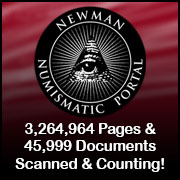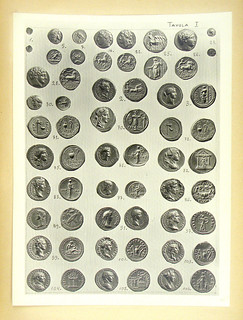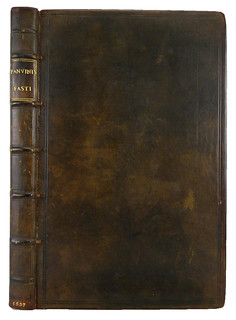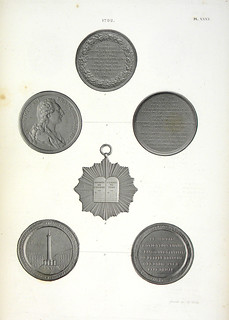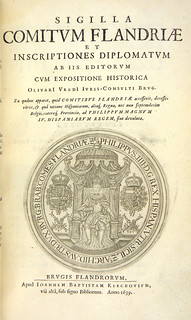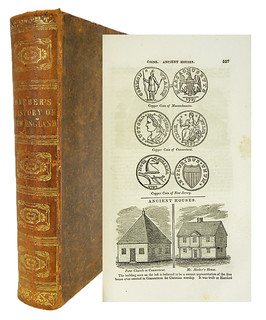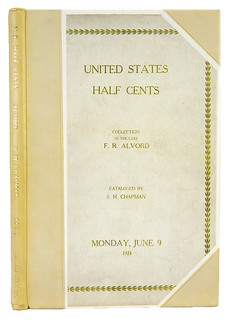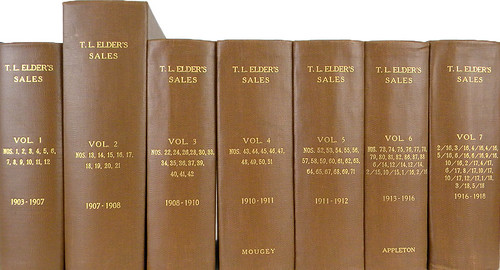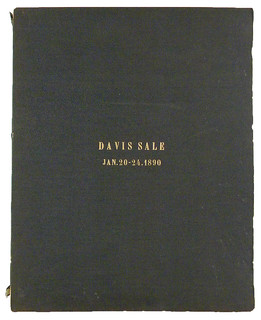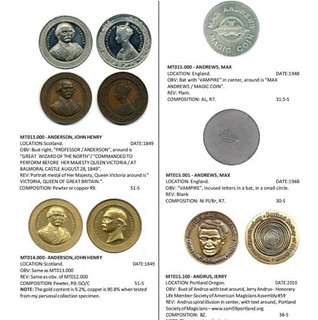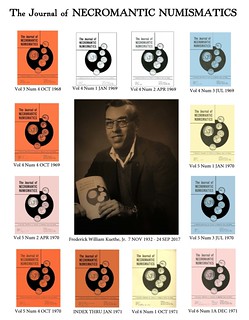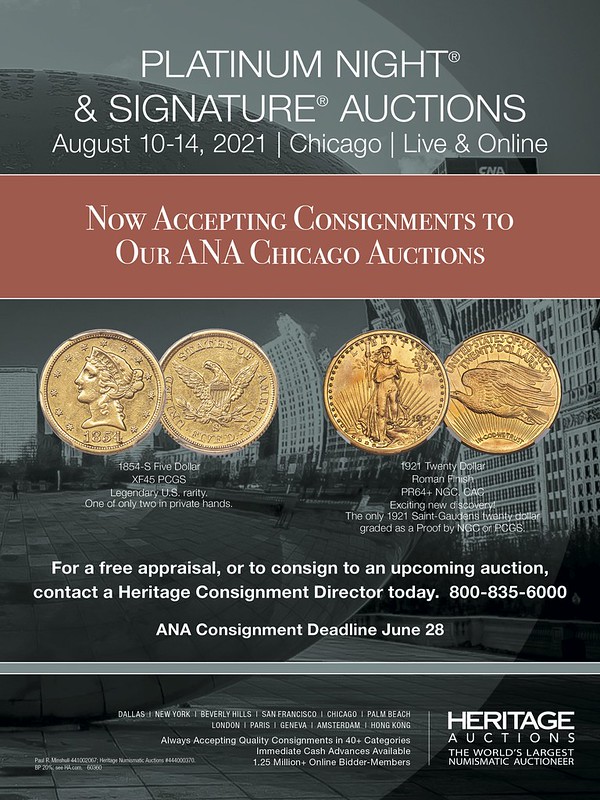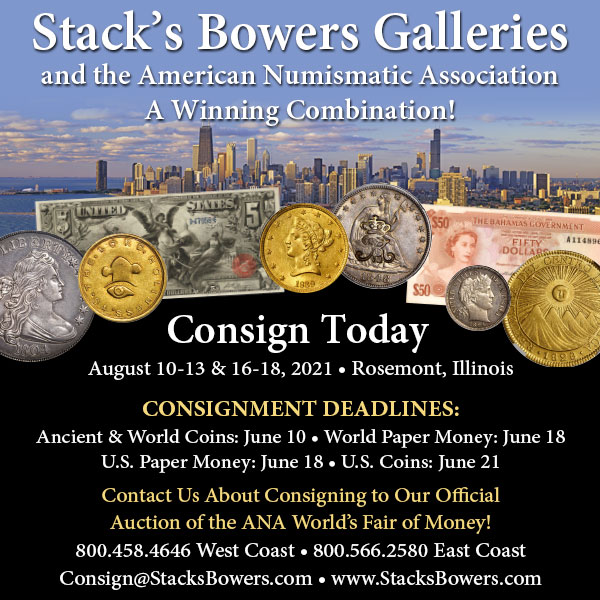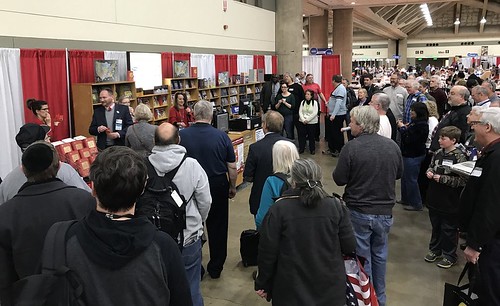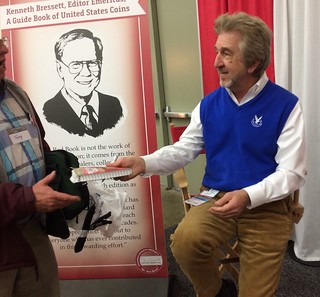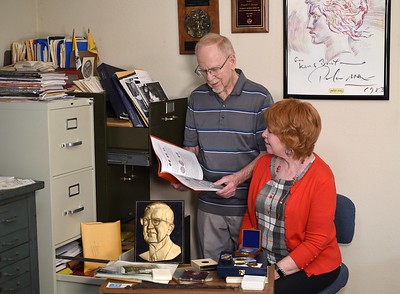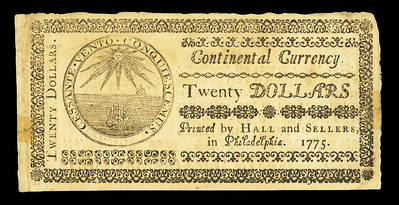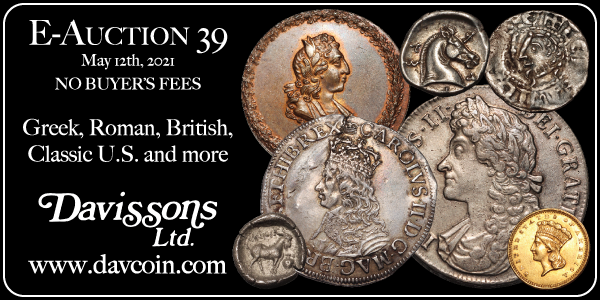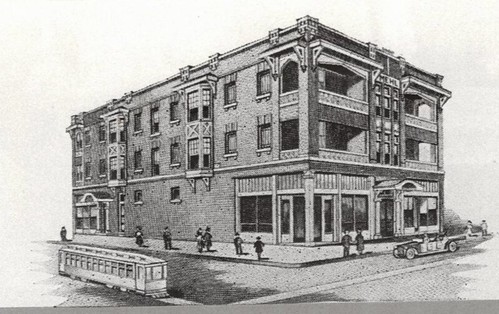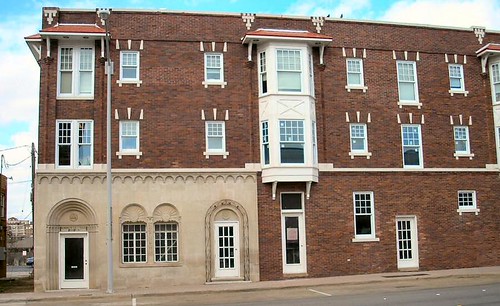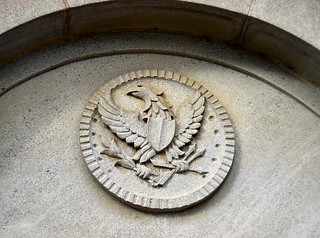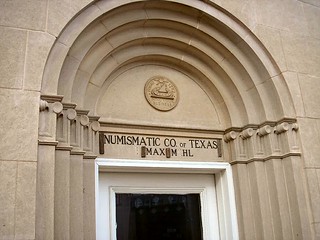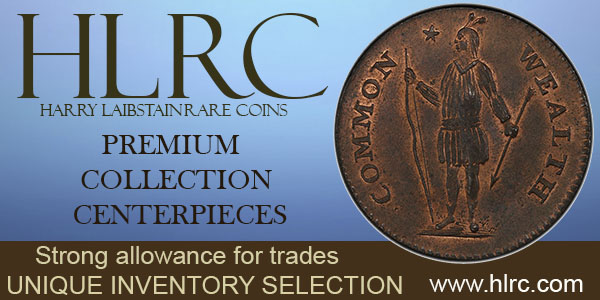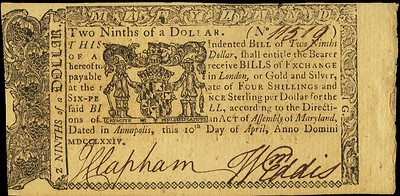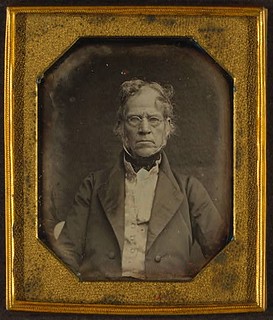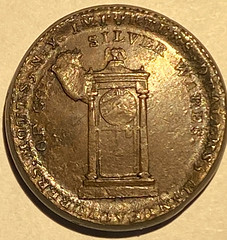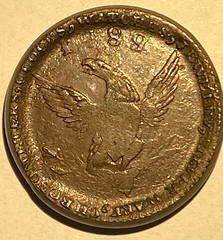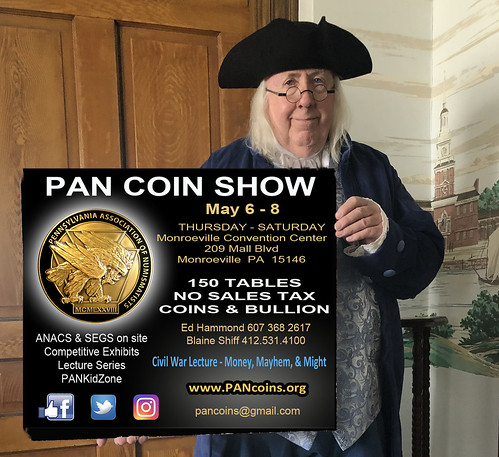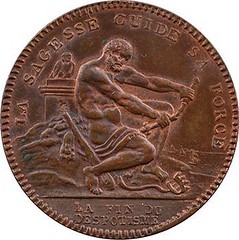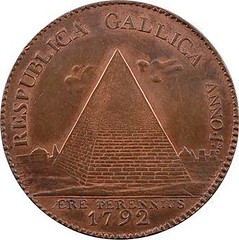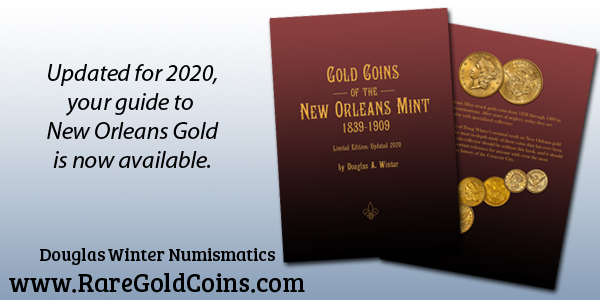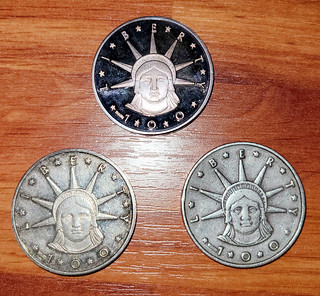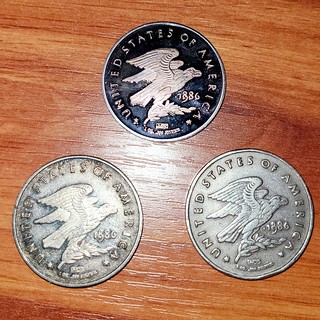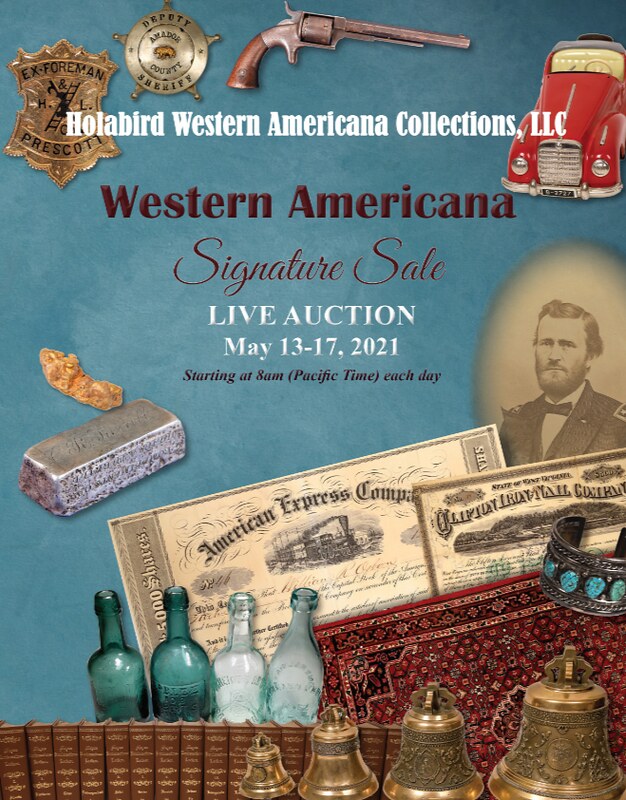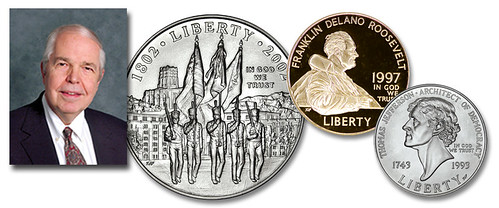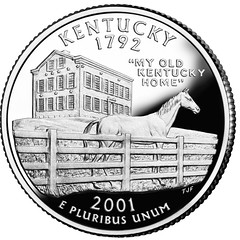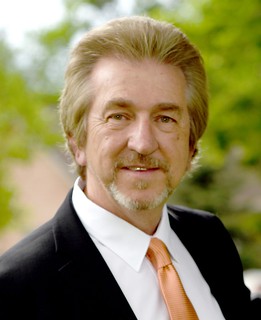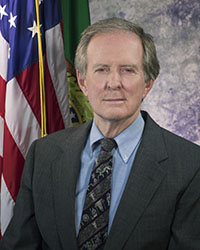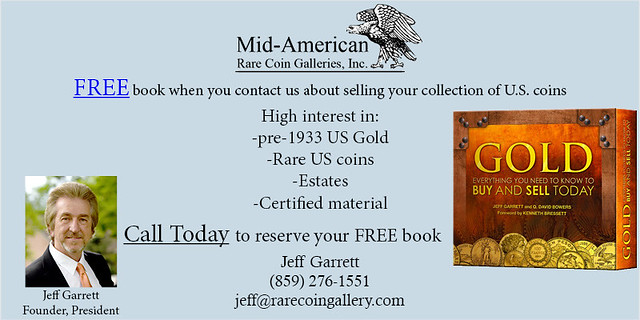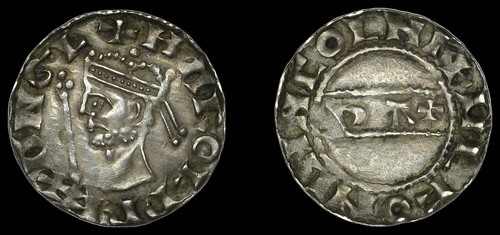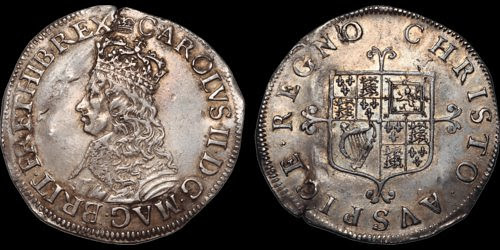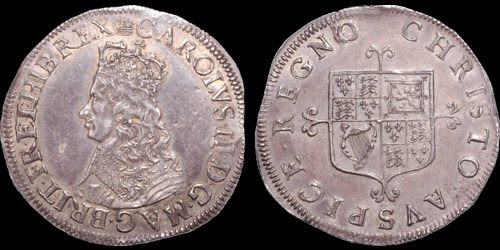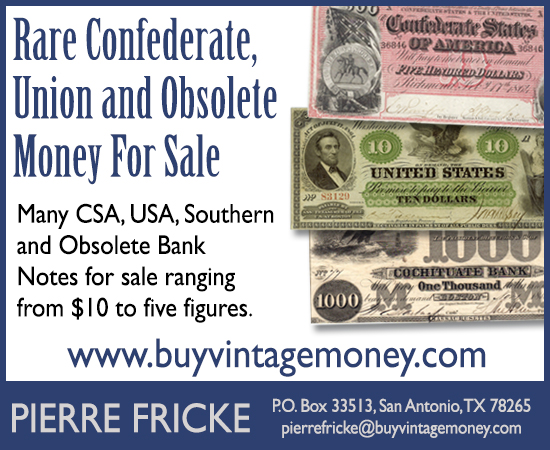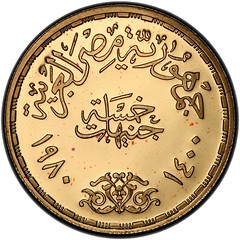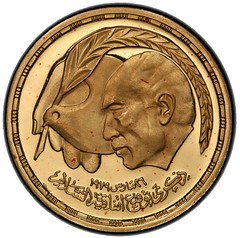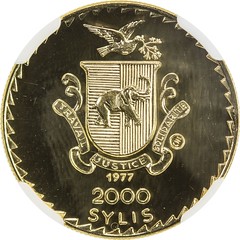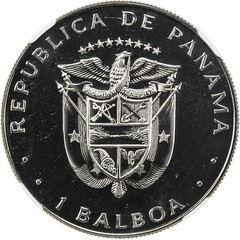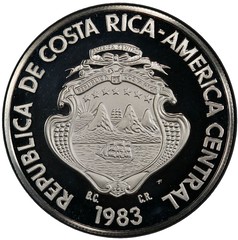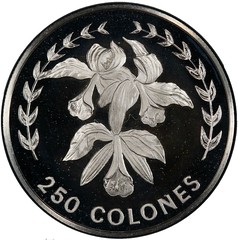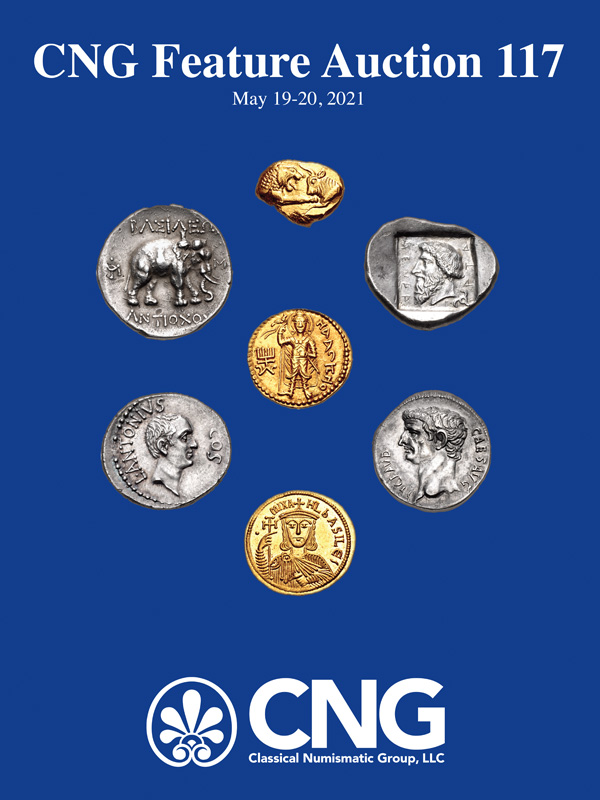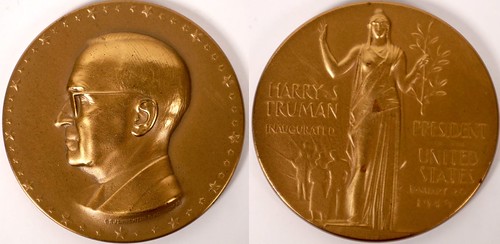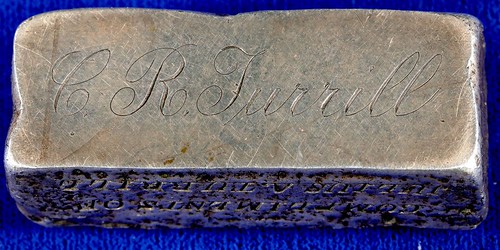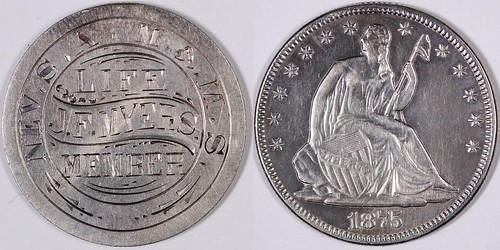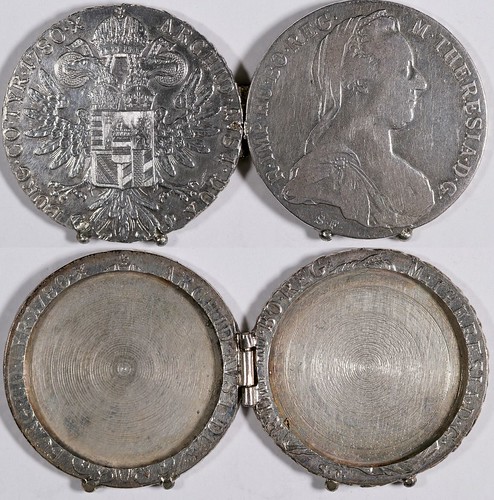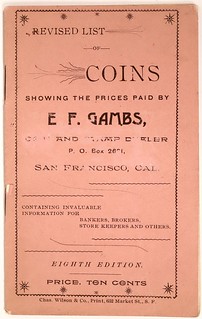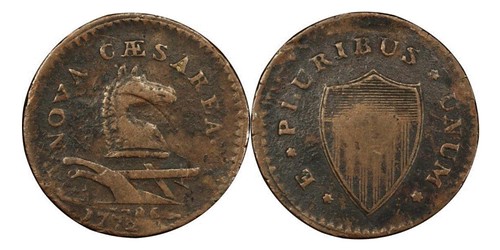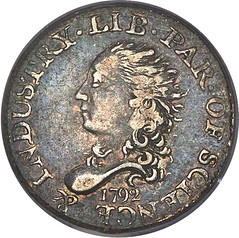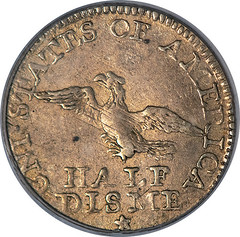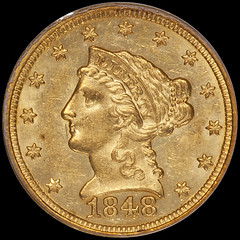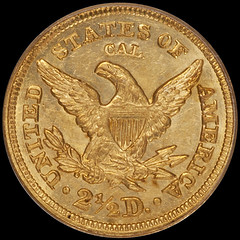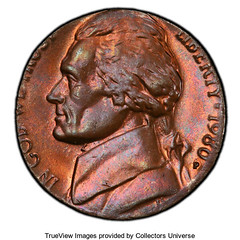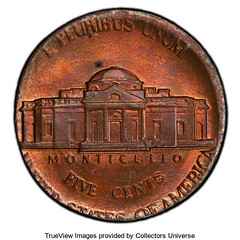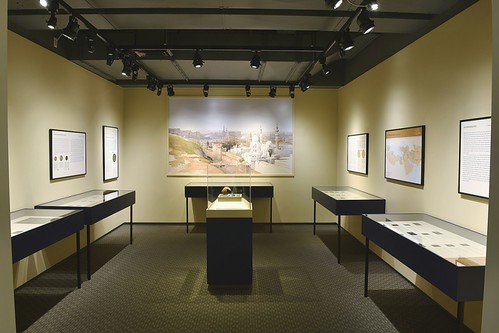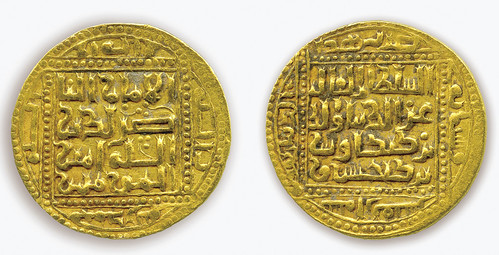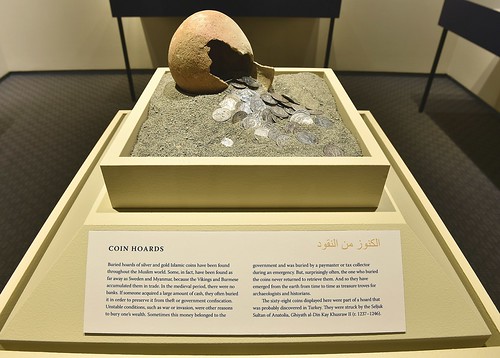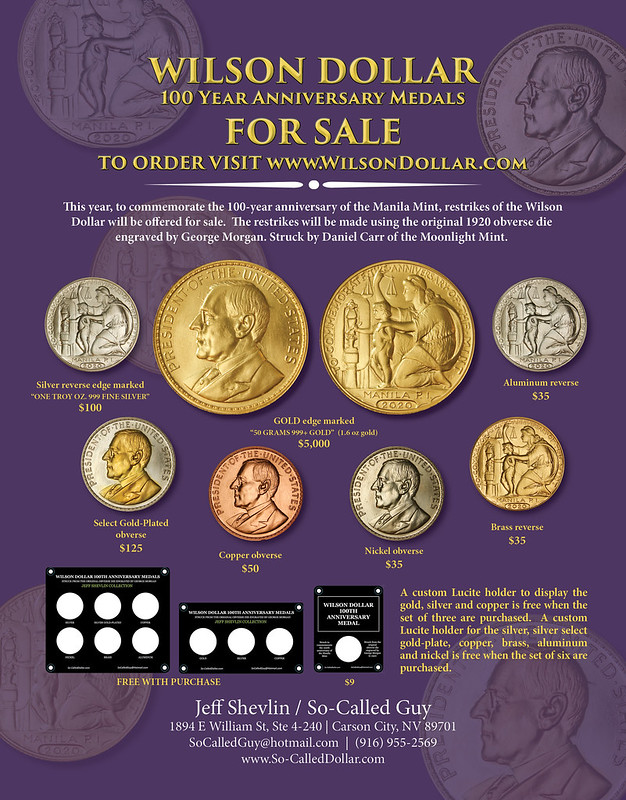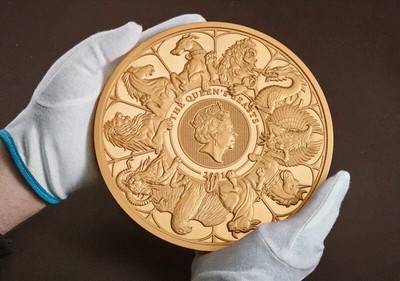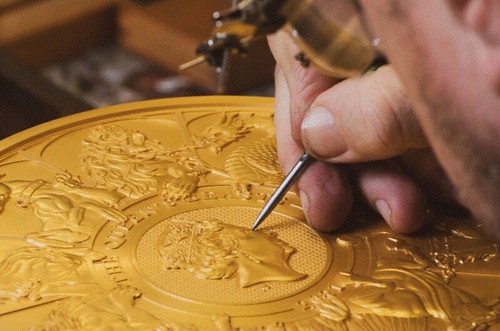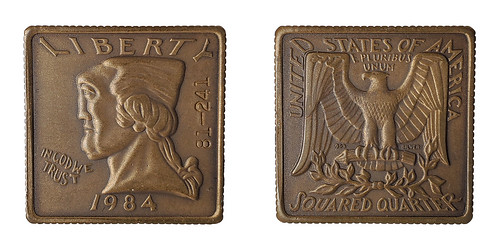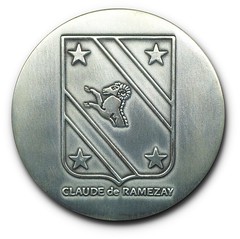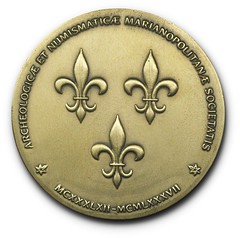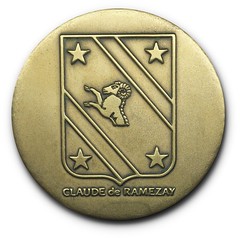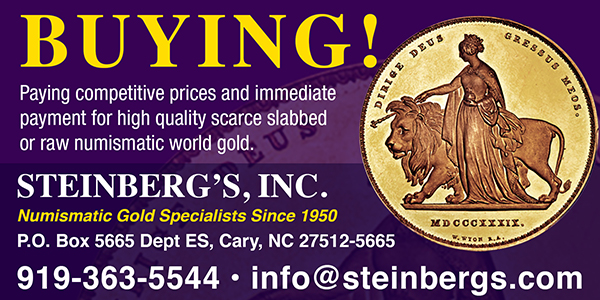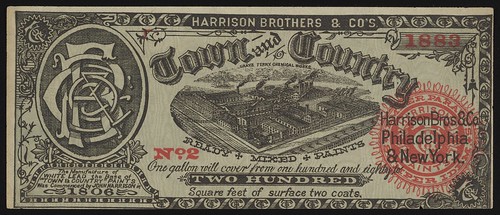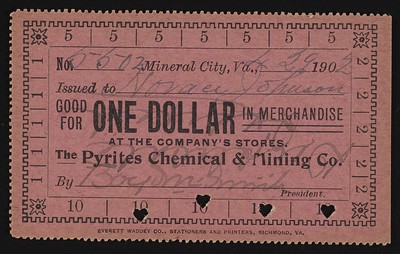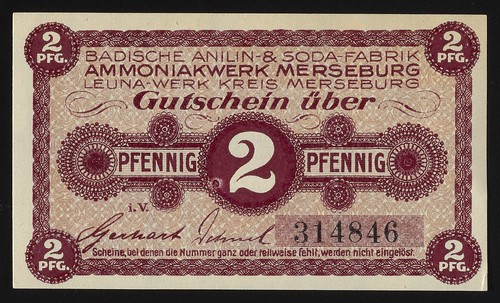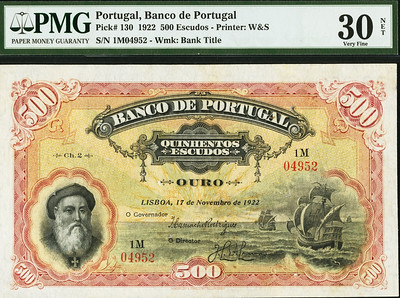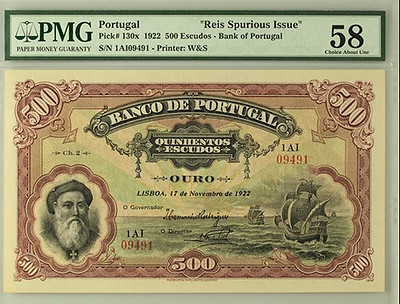
Visit our NBS Sponsors


About UsThe Numismatic Bibliomania Society is a non-profit association devoted to the study and enjoyment of numismatic literature. For more information please see our web site at coinbooks.org SubscriptionsThose wishing to become new E-Sylum subscribers (or wishing to Unsubscribe) can go to the following web page link MembershipThere is a membership application available on the web site Membership Application To join, print the application and return it with your check to the address printed on the application. Print/Digital membership is $40 to addresses in the U.S., and $60 elsewhere. A digital-only membership is available for $25. For those without web access, write to: Charles Heck, Treasurer AsylumFor Asylum mailing address changes and other membership questions, contact Chuck at this email address: treasurer@coinbooks.org SubmissionsTo submit items for publication in The E-Sylum, write to the Editor at this address: whomren@gmail.com BUY THE BOOK BEFORE THE COINSale Calendar |
- WAYNE'S WORDS: THE E-SYLUM MAY 2, 2021
- KOLBE & FANNING AUCTION SALE 160 ANNOUNCED
- NEW BOOK: THE GOLD SOVEREIGN SERIES
- NEW BOOK: MAGIC TOKENS
- NEW BOOK: THE GERMAN BANKNOTES FROM 1871
- NEW BOOK: SECURITY FEATURES OF BANKNOTES
- R.S. YEOMAN AND HIS REMARKABLE RED BOOK
- EARLY PAPER MONEY OF AMERICA ON NNP
- VIDEO: COOL COINS AT COLLECTORAMA 2021
- MORE ON MEHL'S NUMISMATIC BANK BUILDING
- ON INFLUENCE IN NUMISMATICS
- ANSWER: "I.G." ON MARYLAND COLONIAL NOTE
- NOTES FROM E-SYLUM READERS: MAY 2, 2021
- MORE ON THE MONNERON 2 SOL PATTERN PIECE
- QUERY: SHAGIN JOHNSON MATTHEY SILVER ROUNDS
- VOCABULARY TERM: DRAWINGS AND SKETCHES
- SAMUEL BIRCHALL (1761-1814)
- DAVID ULYSSES PROSKEY (1853-1928)
- MINT ENGRAVER T. JAMES FERRELL
- DENNIS TUCKER NOW A KENTUCKY COLONEL
- DNW OFFERS SAMUEL BIRCHALL COLLECTION
- ON CONDITION, DAMAGE, AND PRICE
- MODERN RARE COINS IN ALBUM AUCTION 40
- SELECTIONS FROM HOLABIRD MAY 2021 SALES
- NUMISMATIC NUGGETS: MAY 2, 2021
- AULERCI CENOMANI GOLD STATER FOUND IN JERSEY
- LEISER COLLECTION OF MEDIEVAL ISLAMIC COINS
- IRON AGE COINS IN BRITAIN
- QUEEN'S BEASTS GOLD 10-KILO £10,000 COIN
- THE ANDOR ORAND SQUARED QUARTER
- NUMISMATIC SOCIETY OF MONTREAL MEDALS
- BAUMAN COLLECTION OF CHEMICAL CURRENCY
- 1922 BANK OF PORTUGAL 500 ESCUDOS NOTE
- SCRIPOMANIA AND THE MADNESS FOR SPECULATION
- LOOSE CHANGE: MAY 2, 2021
- THE COIN AND CURRENCY CLUB
Click here to read the thin version on the web
Click here to subscribe
Click here to access the complete archive
To comment or submit articles, reply to whomren@gmail.com
Content presented in The E-Sylum is not necessarily researched or independently fact-checked, and views expressed do not necessarily represent those of the Numismatic Bibliomania Society.
WAYNE'S WORDS: THE E-SYLUM MAY 2, 2021
 New subscribers this week include:
Mike Nixon.
Welcome aboard! We now have 6,641 subscribers.
New subscribers this week include:
Mike Nixon.
Welcome aboard! We now have 6,641 subscribers.
Thank you for reading The E-Sylum. If you enjoy it, please send me the email addresses of friends you think may enjoy it as well and I'll send them a subscription. Contact me at whomren@gmail.com anytime regarding your subscription, or questions, comments or suggestions about our content.
This week we open with a new Kolbe & Fanning numismatic literature sale, four new books, updates from the Newman Numismatic Portal, Mehl's "Numismatic Bank" building, and more.
Other topics this week include Ken Bressett, Johnson Matthey silver rounds, dealer David Proskey, engraver T. James Ferrell, Col. Dennis Tucker, modern rare coins, auction previews, the Queen's Beasts, the squared quarter, and scripomania.
To learn more about the Treasure of Via Alesandrina, magic tokens, German banknotes, banknote security features, the marbled edge $20 Continental Currency issue, the Holiest Coin Collection, the Samuel Birchall collection, Iron Age Coins in Britain, the Pedley Ryan dollar, the 1848 CAL. Quarter Eagle, the Antiquarian and Numismatic Society of Montreal, chemical currency, and "Britcoins", read on. Have a great week, everyone!
Wayne Homren
Editor, The E-Sylum
THE BOOK BAZARRE
KOLBE & FANNING AUCTION SALE 160 ANNOUNCED
Kolbe & Fanning have announced their next numismatic literature sale. Some great material here. -Editor
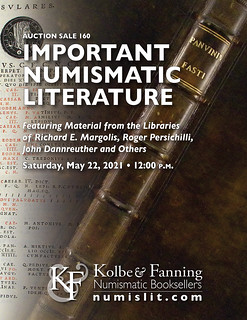 Kolbe & Fanning May 22 Book Auction
Kolbe & Fanning May 22 Book Auction
Kolbe & Fanning Numismatic Booksellers are announcing our Sale 160, which will be held on Saturday, May 22, 2021. The 459-lot sale features additional material from the library of Richard Margolis, along with selections from Roger Persichilli, John Dannreuther, and the TAB Library. The sale includes books, catalogues and other publications on a variety of numismatic topics, including standard current works, antiquarian volumes, rare plated catalogues, and much else.
Some highlights of the sale include:
Lot 30: the rare 1942 catalogue of the "Treasure of Via Alesandrina," with original mounted photographic plates illustrating this important find
Lot 92: a handsome copy of the 1557 first edition of Onofrio Panvinio's Fasti et triumphi Romanorum
Lot 257: the volume of the Trésor de numismatique et de glyptique dealing with medals of the French Revolution, bound in 19th-century half morocco
Lot 329: an impressive volume of works by Olivarius Vredius on Flemish sigillography, including his important 1639 Sigilla comitum Flandriae et inscriptiones diplomatum
Lot 347: a well-preserved copy of John Warner Barber's 1841 History and Antiquities of New England, New York, and New Jersey, with illustrations of state coppers
Lot 366: S.H. Chapman's very rare plated catalogue of his 1924 sale of the F.R. Alvord collection of United States half cents
Lot 377: the extraordinary Fuld-Bass set of Tom Elder catalogues, featuring five plated sales (including the very rare 1907 Chase sale), and also including his extremely rare first mail-bid sale
Lot 370: an original 1875 copy of Crosby's Early Coins of America, with the 1873 Introduction, an 1874 circular, and some original paper covers bound in
Lot 409: John J. Ford, Jr.'s copy of the New York Coin & Stamp Company's 1890 catalogue of the R. Coulton Davis collection, with plates, in original flexible cloth covers
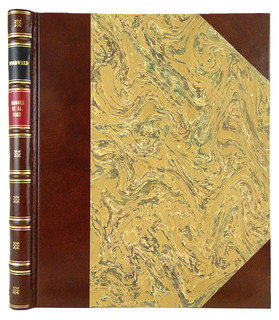 Lot 438: a finely bound large-paper copy, interleaved and hand-priced, of W. Elliot Woodward's second Semi-Annual Sale (April–May 1863).
Lot 438: a finely bound large-paper copy, interleaved and hand-priced, of W. Elliot Woodward's second Semi-Annual Sale (April–May 1863).
Register early to bid online
Bids may be placed via post, email, fax or phone, as well as online. Kolbe & Fanning use Auction Mobility as our third-party online bidding platform. Auction Mobility is an app-based platform allowing users the ability to participate in the sale through phones, tablets and computers. To register for the sale, bidders must go to bid.numislit.com and sign up. Once you have set up an account, you may browse lots, place advance bids, or participate in the live sale online. Those wishing to participate on their devices can download the Kolbe & Fanning app through the Apple or Google Play Store.
The printed catalogue of Sale 160 will be mailed to all active customers on our mailing list shortly. As international mail speeds remain somewhat slowed by the Corona situation, we encourage our international clients to consult the electronic catalogue in case their printed catalogue does not arrive promptly. A PDF of the printed catalogue has been posted to our main website at numislit.com for those who prefer that format. Bids placed via post, email, fax or phone must be received by May 21, the day before the sale, in order for them to be processed. Advance absentee bids may also be placed at any time online at bid.numislit.com. Live internet bidding will be available during the sale itself through the same platform. The sale will also be listed on Biddr and NumisBids in the near future.
Kolbe & Fanning Numismatic Booksellers LLC is a licensed and bonded auction firm in the State of Ohio. For more information, please see the Kolbe & Fanning website at numislit.com or email David Fanning at df@numislit.com. To register for the sale, go to bid.numislit.com. We look forward to your participation.
NEW BOOK: THE GOLD SOVEREIGN SERIES
Token Publishing, Publishers of Coin News and Medal News, have announced a new edition of their book on the gold sovereign coinage. -Editor
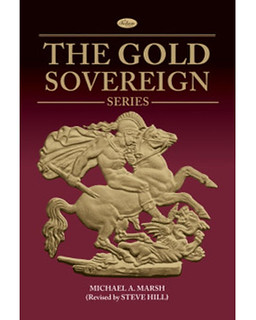 The first revised edition of the Token Publishing Ltd imprint of Michael Marsh's The Gold Sovereign was published in 2017 to coincide with the 200th anniversary year of the famous coin. Since then this book, fully revised and updated by Steve Hill of Sovereign Rarities (formerly of Spink and Baldwins) has become the reference work on the sovereign, half sovereign and quarter sovereign.
The first revised edition of the Token Publishing Ltd imprint of Michael Marsh's The Gold Sovereign was published in 2017 to coincide with the 200th anniversary year of the famous coin. Since then this book, fully revised and updated by Steve Hill of Sovereign Rarities (formerly of Spink and Baldwins) has become the reference work on the sovereign, half sovereign and quarter sovereign.
The new edition, now entitled The Gold Sovereign Series, is available NOW, and once again it has been updated by Steve with all new sovereigns and fractionals issued since 2017 added, Also, for the very first time, the five sovereign and two sovereign coins are included too, all in one hardbound, profusely illustrated 272-page volume, making this the absolutely definitive work on the iconic series. This long-awaited second edition is available to order today priced at £39.95 (post-free if ordered before midnight on May 3) and comes complete with an accompanying price and rarity guide.
For more information, or to order, see:
The Gold Sovereign Series
(https://www.tokenpublishing.com/shop/product/8058/16)
NEW BOOK: MAGIC TOKENS
We recently discussed an unusual Whitehead & Hoag token that some speculated was a magician's piece. John Mutch recently learned about a recent book on the topic from a Facebook post. I don't believe we've discussed this one before. First here's the background from the FB Topmagician1 feed (September 14, 2018). -Editor
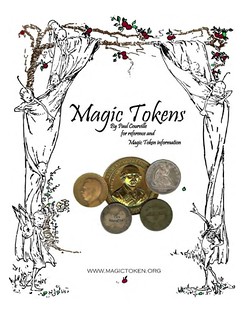 This note is being sent out to all collectors of magic, and specifically magic tokens, that we know about. Over the past few years, Paul Courville has been working with Robert A. Olson on an update of the noted book Magic Tokens and Related Items, by F. William Kuethe. This was published by the Token and Medal Society in 1978 and listed over 400 tokens (now simply called Magic Tokens). Today, that number of known tokens has more than doubled. When Robert A. Olson told Kuethe about it, and shared Courville's website with him, Kuethe's response was, "If there is anything that I can do to help, please let me know". The book will be available on line by going to
http://www.magictoken.org/ (then click on THE MAGIC TOKEN GUIDE button).
This note is being sent out to all collectors of magic, and specifically magic tokens, that we know about. Over the past few years, Paul Courville has been working with Robert A. Olson on an update of the noted book Magic Tokens and Related Items, by F. William Kuethe. This was published by the Token and Medal Society in 1978 and listed over 400 tokens (now simply called Magic Tokens). Today, that number of known tokens has more than doubled. When Robert A. Olson told Kuethe about it, and shared Courville's website with him, Kuethe's response was, "If there is anything that I can do to help, please let me know". The book will be available on line by going to
http://www.magictoken.org/ (then click on THE MAGIC TOKEN GUIDE button).
By sharing this knowledge with all, freely and willingly, It will become a clearing house of knowledge on magic tokens, as collectors can send in new tokens to be listed and researched. It will be updated quarterly to keep it current. There is no charge to use this book. Kuethe shared his knowledge on magic and tokens with all. We will do the same. For those who would like printed copies, they will be made available on Amazon. Please share this posting with fellow collectors.
Additionally, Magic Tokens is now released for purchase in physical book format for those interested in adding it to their own personal reference books collection.
Here's some information from the Amazon product page. There are several sample pages available, and the work looks well organized and professionally done, with color photos throughout. -Editor
Magic Tokens Paperback
by Paul J. Courville
One of the areas of magic history is in the advertising coins, or magic tokens, used by magicians. From long ago to the present day, magicians have been using these in their shows, and to advertise their performances. The book that you will now read will help document these tokens. The documentation of Magic Tokens was begun in the United States by John Mulholland, and Edgar Heyl, and then formalized in 1978 by F. William Kuethe, Jr., when the Token and Medal Society published his Magic Tokens and Related Items. The documentation now continues, based on the work of Kuethe. It continues here.
About the Author
Born in Jonesboro Arkansas on April 16th, 1959. I joined the United States Army at the age of 17 and retired from military service 24 years and 13 days later. I'm now working as a Network Administrator and have a lovely wife named Lisa. We now live in Greenwood Indiana.
Product details
Publisher : CreateSpace Independent Publishing Platform (September 12, 2018)
Language : English
Paperback : 169 pages
ISBN-10 : 1727158539
ISBN-13 : 978-1727158533
Item Weight : 1.04 pounds
Dimensions : 8.5 x 0.4 x 11 inches
For more information, or to order, see:
Magic Tokens Paperback – September 12, 2018
(https://www.amazon.com/dp/1727158539/)
The Magictoken.org site also mentions a periodical I'd never heard of - The Journal of Necromantic Numismatics published by Frederick Kuethe, Jr., issued from 1966-1978. Has anyone seen this? Does a library somewhere have a run of them? -Editor
To read the earlier E-Sylum article, see:
THE MYSTERIOUS WHITEHEAD & HOAG TOKEN
(https://www.coinbooks.org/v24/esylum_v24n16a11.html)
NEW BOOK: THE GERMAN BANKNOTES FROM 1871
OK, here's another new edition of a numismatic book written in German. But I think we're safe translating this title to English. It's a book on German banknotes from 1871 onward. Here's a Google-translated description from the publisher's website. -Editor
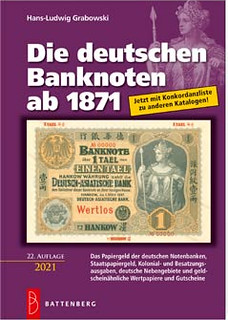 The German banknotes from 1871
The German banknotes from 1871
by Hans-Ludwig Grabowski
The paper money of the German central banks, government paper money, colonial and occupation expenses, German secondary areas and banknote-like securities and vouchers
Published by Battenberg Verlag
ISBN: 978-3-86646-183-3
Edition: 22nd edition 2020
Images: colored throughout
Hardcover: 928 pages
Format: 14.8 x 21 cm
The current standard work on German banknotes from the establishment of the Empire in 1871 to the present day of the euro, structured according to historical epochs: Empire, "Weimar Republic", "Third Reich", Allied occupation, GDR, Federal Republic and secondary areas. In addition to the notes of the German central banks (including the federal state central banks), government paper money, colonial and occupation expenses, banknote-like securities and vouchers as well as occupation expenses from both World Wars and military money were recorded. To improve clarity, the main and secondary areas have been separated from one another while retaining the new numbering introduced in the 21st edition. All areas are cataloged with their own number ranges and are currently rated. An extensive concordance list of all editions of the "Rosenberg Catalog" and the standard "World Paper Money" catalogs has been included in the appendix. The catalog includes:
Main areas:
- German Empire 1871–1918
- "Weimar Republic" 1918–1933
- "Third Reich" 1933–1945
- Allied occupation 1945–1948
- German Democratic Republic 1949–1990
- Federal Republic of Germany 1949–1999
- European Monetary Union from 2002
Subsidiary areas:
- German state and private central banks 1871–1930
- Deutsche Reichsbahn 1923
- Paper money-like securities and vouchers 1933–1944
- German occupation expenses First World War 1914–1918
- German occupation expenses Second World War 1939–1945
- Bank notes for German secondary areas (Danzig, Memel, Saar area) 1922– 1947
For more information, or to order, see:
Die deutschen Banknoten ab 1871
(https://www.battenberg-gietl.de/sammeln/buch/die-deutschen-banknoten-ab-1871)
NEW BOOK: SECURITY FEATURES OF BANKNOTES
Roland Rollins has published a new book on security features of modern banknotes. -Editor
 There are 7 chapters covering generic security features and over 200 trade name security features, 90% with image examples. Chapters include
There are 7 chapters covering generic security features and over 200 trade name security features, 90% with image examples. Chapters include
- Printing Methods
- Watermarks and Windows
- Inks
- Security Strips
- Security Mask
- Foil, & Patch
- Substrates
- Varnishes & Coatings
The book runs 69 pages.
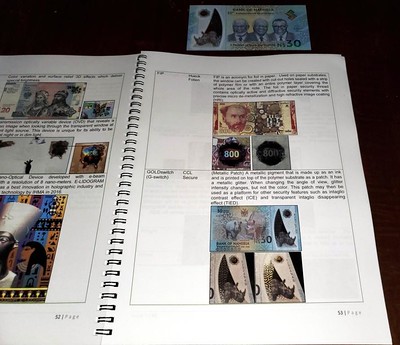 The 39 firms with proprietary security devices annotated are: 3d AG , Advanced Track & Trace , Aestron Design , Arjo Wiggins , Bank of France , Canadian Bank Note Company , CCL Secure , China Banknote Ink Co., Crane , De La Rue , Demax , Fabriano , FNMT , Giesecke & Devrient , Goznak , Graphic Security Systems , Hologram Industries , Hueck Folien, International Security Products , Inovink , Jura , Koenig & Bauer , Krypten , Kurz , Landqart , Louisenthal , Merck , Nanotech , Oberthur Fiduciaire , OeBS , Omron Corporation , Orell Füssli , PNO Global , PWPW, Securency , SICPA, SURYS, Toppan, and Zhongchao Special Security Technology.
The 39 firms with proprietary security devices annotated are: 3d AG , Advanced Track & Trace , Aestron Design , Arjo Wiggins , Bank of France , Canadian Bank Note Company , CCL Secure , China Banknote Ink Co., Crane , De La Rue , Demax , Fabriano , FNMT , Giesecke & Devrient , Goznak , Graphic Security Systems , Hologram Industries , Hueck Folien, International Security Products , Inovink , Jura , Koenig & Bauer , Krypten , Kurz , Landqart , Louisenthal , Merck , Nanotech , Oberthur Fiduciaire , OeBS , Omron Corporation , Orell Füssli , PNO Global , PWPW, Securency , SICPA, SURYS, Toppan, and Zhongchao Special Security Technology.
The cost is $25 with free shipping within the U.S. and $6 shipping worldwide. The book is available on Ebay, Delcampe, and directly at:
http://currency_den.tripod.com/Travis/travis.html
R.S. YEOMAN AND HIS REMARKABLE RED BOOK
Dennis Tucker of Whitman Publishing penned this article with additional information on R.S. Yeoman and the new book about the Red Book founding editor. -Editor
A Penny Saved: R.S. Yeoman and His Remarkable Red Book, the latest Whitman Publishing book by Kenneth Bressett, debuts in summer 2021 to celebrate the 75th anniversary of Yeoman's Guide Book of United States Coins (the "Red Book"). The 352-page hardcover volume will be available from bookstores and hobby shops and online (including at Whitman.com), and in the meantime is available for preorder. Here, Whitman publisher Dennis Tucker describes the process of how A Penny Saved came to be, and why it was undertaken in the first place.
Celebrating R.S. Yeoman and His Remarkable Red Book
How and Why We Commemorate the Red Book's 75 Years
For more than 50 years, Kenneth Bressett skillfully shepherded the Guide Book of United States Coins—the hobby's beloved "Red Book"—as its coordinating and senior editor. For generations of coin collectors he has been the face of the Red Book, much as R.S. Yeoman was to earlier hobbyists.
Red Book Research Editor Dave Bowers and Editor Emeritus Ken Bressett (both seated) are two founding members of the Rittenhouse Society. Here they are surrounded by members of the Society who attended the American Numismatic Association World's Fair of Money, Anaheim, 2016. Left to right: P. Scott Rubin, George Frederick Kolbe, Joel J. Orosz, David Fanning, Wayne Homren, Denis Loring, Mark Borckardt, Jeff Garrett, Bill Bugert, Barbara Gregory, Ron Guth, John Dannreuther, Tom DeLorey, John Kraljevich, David W. Lange, Len Augsburger, Neil Shafer, Doug Mudd, David T. Alexander, Dennis Tucker, and guest Deb Wurtz.
I never met Ken's predecessor in person. Yeoman was winding down in the mid-1980s, when my own life as an active young collector was just gearing up. But working as Ken's publisher and frequent collaborator for the past 16-plus years, I've come to know R.S. Yeoman quite well. I've learned from Ken the "Yeoman way" of thinking about and managing the Red Book and the Blue Book, and now Mega Red. His philosophy and approach have become second nature to me. Notice when I say "his philosophy and approach," I don't specify whose—because Yeoman's and Bressett's are one and the same. Not only did Ken learn his mentor's style, but he has thoughtfully and steadfastly emulated it since the 1960s. That's a remarkable demonstration of one professional's respect for another.
Meanwhile, a defining part of Ken's personality is constant humility in spite of his own brilliance and productive hard work. "If it takes a village to raise a child," he's told me, "then equally it takes a large, dedicated group of individuals to produce a formidable publication like the Red Book." He quickly gives credit to the generations of coin collectors and dealers whose contributions have made the book a success. And of course he credits the vision and energy of Yeoman and others who founded the Blue Book and Red Book, as well as all the typesetters, assistant editors, graphic designers, factory workers, distributors, retailers, and others who have done their part. Ken's modesty and courteous generosity only add to the kudos he himself so richly deserves.
Why Celebrate the Red Book?
Surely every book that's seen 75 editions and sold in the tens of millions has a story to tell, and deserves to have it told. As Ken has said, "It would be impossible to appreciate the story of the Red Book's birth and development without a broad knowledge of its author himself; the publisher and printing facility that produced it; and the throng of talented individuals who contributed to its creation and continued success."
He further observes, "Sad as it is, most of the participants involved in producing the early editions are no longer with us, and even the best of memories tend to fade with time."
Ken wanted to bring together as much information as possible before it was lost to future generations. He took up the challenge of reconstructing the Red Book's historical background based on his personal knowledge and close working association with Whitman Publishing over many years.
Whitman has been in business for more than a hundred years. Racine was its home for decades. Then, from the 1980s to early 2000s, the company and its ownership and management moved a few times—from Wisconsin to New York and down South, with points in between. Unfortunately, some of the physical moves resulted in a gradual loss of material culture—historical records, old letters, corporate items like plaques and awards, and similar artifacts.
"The task at first seemed nearly impossible," Ken said, "until recent investigation uncovered a treasure trove of factual material related to every phase of Red Book production." This allowed him to study much previously unknown (or unpublished) background of when, why, and how the Red Book came about. The trove included R.S. Yeoman's personal papers, documents, files, correspondence, and artifacts related to his long and successful life and career.
At the March 2018 Whitman Baltimore Coin and Collectibles Expo, Red Book fans assembled for a giveaway of the hardcover 72nd edition, which featured a gold-foil portrait of Editor Emeritus Kenneth Bressett on the back. (Photograph by Steve Roach, editor-at-large, Coin World)
Equally exciting was the almost simultaneous discovery of much of the original Western Archives, described by Ken as "documentation, data, background stories, and materials from Western Publishing Company files, including perhaps every numismatic book ever published by the firm, and curiosities that no one ever dared to think still existed."
How A Penny Saved Came Together
Ken proposed a manuscript to Whitman in the summer of 2019. I'll never forget talking with him about it at the American Numismatic Association World's Fair of Money that August, in Chicago. The idea of celebrating R.S. Yeoman's life, showing coins from Yeoman's own collection, publishing his handwritten notes, telling the Red Book story and of the old days at Western and Whitman—it was a dream manuscript pitch!
Much of the detailed architecture of chapter 1 of A Penny Saved, the story of Western Printing & Lithographing and the birth of Whitman Publishing, is built on the foundation of Frank J. Colletti's Guide Book of the Official Red Book of United States Coins. (That book, volume 14 in Whitman's Bowers Series, is highly recommended for its fascinating edition-by-edition study of Yeoman's famous scarlet tome.) To that foundation Ken added material and information from the Western Archives and other resources.
Ken Bressett, unable to attend the March 2018 Baltimore Expo in person because of the winter weather, nevertheless was a constant presence! Senior Editor Jeff Garrett autographed Red Books next to a poster with his portrait.
In several places the assistance of David W. Lange, preeminent scholar of the history of coin albums and folders, was crucial. Robert Kelley, museum specialist and photography director for the American Numismatic Association, beautifully photographed many of the medals, framed portraits, books, and other vintage artifacts. Stack's Bowers Galleries opened its auction archives for images of coins, tokens, paper money, and medals, common and rare. Lawrence Block, Lincoln Higgie, Ed Metzger, and Neil Shafer shared personal memories of their work at Whitman Publishing. Philip Bressett, Ken's eldest son, offered his unique perspective and insight.
Ken was aided in the enormous task of studying, sorting, organizing, and presenting the story by Barbara J. Gregory, recently retired longtime editor of the ANA's popular magazine, The Numismatist. Other individuals and companies helped in many ways, as noted in the book's credits and acknowledgments.
Of course, the brightest mint luster on A Penny Saved is Ken Bressett's personal involvement as author. He can recount the true stories, expose the myths and legends, and confirm the hidden facts because he was eyewitness to most of the Red Book's history. On top of that, his own remarkable life is presented as a warmly personal and richly illustrated autobiography, found in chapter 6.
Ken Bressett and Barbara Gregory in 2020, reviewing archival materials while working on A Penny Saved: R.S. Yeoman and His Remarkable Red Book.
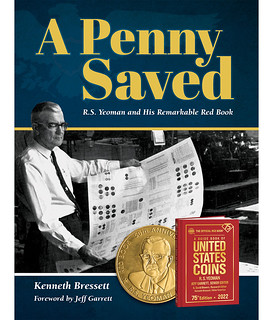 The Red Book Belongs to Every Hobbyist
The Red Book Belongs to Every Hobbyist
So that's the "why" and "how" of A Penny Saved. This book itself now becomes part of the Red Book story. If you're a collector of United States coins, you're already part of the story, as well, especially if you're 75 years old or younger—the Red Book has always been a presence in your hobby! After you read A Penny Saved and learn the history of Western Printing, Whitman Publishing, R.S. Yeoman, and Ken Bressett, you'll be able to share this remarkable story of our hobby with the next generation of collectors.
A Penny Saved: R.S. Yeoman and His Remarkable Red Book
By Kenneth Bressett; foreword by Jeff Garrett.
ISBN 0794849016. Hardcover, 8.5 x 11 inches, 352 pages, full color.
Retail $39.95 U.S.
https://whitman.com/a-penny-saved-r-s-yeoman-and-his-remarkable-red-book/
To read the earlier E-Sylum article, see:
NEW BOOK: A PENNY SAVED
(https://www.coinbooks.org/v24/esylum_v24n16a02.html)
EARLY PAPER MONEY OF AMERICA ON NNP
Newman Numismatic Portal Project Coordinator Len Augsburger provided this report on the latest updates to Newman's Early Paper Money of America. Thanks. -Editor
Early Paper Money of America on Newman Portal
We continue to update the NNP Edition of Eric Newman's Early Paper Money of America. This online version incorporates additional images from the Newman paper money sales, in addition to edits contributed by collectors and researchers. Ray Williams, David Gladfelter, and others have contributed to this ongoing effort.
One of the most iconic notes in this series is the marbled edge $20 from the Continental currency issue of May 10, 1775. This anti-counterfeiting measure is visually stunning, so much so that it was selected for the front cover of the fifth edition of Early Paper Money of America. The legislation for the May 10 issue, a resolution of the Continental Congress on June 22, 1775, contains an allusion to slavery: "That the propotion or quota of each colony be determined according to the number of inhabitants of all ages, including negroes and mulattos, in each colony." This stands in opposition to the first article of the Constitution as ratified in 1788, which counted slaves at a rate of 3/5 for the purposes of determining the makeup of the House of Representatives. A broadside of the June 22, 1775 resolution is known (Evans Early American Imprints 42963) and is represented in a number of institutional collections. Owners of the $20 marbled edge notes may wish to keep an eye out for this compelling "go with" item.
Image: Marbled edge Continental Currency note of May 10, 1775, ex. Newman VIII (Heritage Auctions 11/2017), lot 28170, realized $26,400.
Link to Early Paper Money of America on Newman Portal:
https://nnp.wustl.edu/library/imagecollection/513468
VIDEO: COOL COINS AT COLLECTORAMA 2021
These are selections from the David Lisot Video Library that feature news and personalities from the world of coin collecting. David has been attending coin conventions since 1972 and began videotaping in 1985. The Newman Numismatic Portal now lists all David's videos on their website at:
https://nnp.wustl.edu/library/multimediadetail/522852
Here's another one from the recent Collectorama show, highlighting several of the interesting coins offered there. -Editor
Cool Coins at Collectorama 2021!
VIDEO: 8:27.
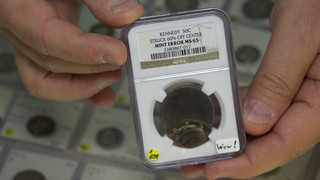 David Lisot, Interviewer, CoinTelevision.com with Edward Kuszmar, John Maben, Owner, Pegasus Coin & Jewelry, Rick & Patricia DeSanctis, Numismatic Classics.
David Lisot, Interviewer, CoinTelevision.com with Edward Kuszmar, John Maben, Owner, Pegasus Coin & Jewelry, Rick & Patricia DeSanctis, Numismatic Classics.
Cool coins can be almost any coins. Hear and see interesting concepts of coolness for coins that include the American Eagle gold 1/10 ounce uncirculated, an off-center Kennedy Half Dollar, multiple one ounce copper uncirculated rounds, and an 1882-CC GSA Toned Silver Dollar NGC MS65.
An excerpt of the video is available for viewing on the Coin Television YouTube Channel at:
https://youtu.be/gPwKlObkV4U
MORE ON MEHL'S NUMISMATIC BANK BUILDING
Dave Lange writes:
"Peter Huntoon grieved over alterations to B. Max Mehl's Numismatic Bank building, but for a structure that old it has retained most of its original character. The only obvious alteration is enclosure of the open balconies.
I visited the Mehl Building in 2003 while it was being renovated, but I don't have my photos of that trip handy. Attached are some shots from five years later, when the work was completed. These were taken while the leaves were off the trees, so they provide a better view of its details."
Jim Neiswinter writes:
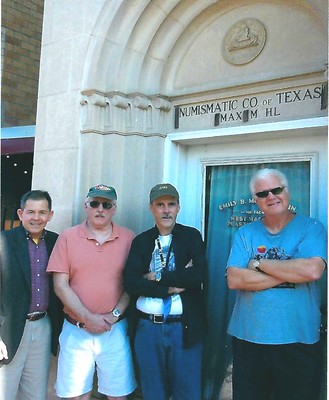 "At the 2015 Early American Coppers (EAC) convention in Dallas a few of us traveled to Ft. Worth to see the Max Mehl building. In 1916 Mehl built his building at 1204 W. Magnolia Ave. Above the front door is a stone carving of a Fugio Cent.
"At the 2015 Early American Coppers (EAC) convention in Dallas a few of us traveled to Ft. Worth to see the Max Mehl building. In 1916 Mehl built his building at 1204 W. Magnolia Ave. Above the front door is a stone carving of a Fugio Cent.
"The building fell into disrepair and was closed in the early 1980s. From 2005 to 2007 it was restored at a cost of $2.4 million – almost 100 times its original cost.
"We also went to Mehl's home at 2512 S. Adams St. Since there was a For Sale sign on the front lawn and the house seemed vacant we walked around the property and looked in the windows. We were surprised when a young man opened the door and asked us W.T.F we were doing. It seems our explanation was good enough because he didn't call the police.
"The four people are Rich Webber, Jan Valentine, myself, and Dane Neilson."
Thanks, everyone! Great photos. -Editor
To read the earlier E-Sylum article, see:
NOTES FROM E-SYLUM READERS: APRIL 25, 2021 : The B. Max Mehl Building Today
(https://www.coinbooks.org/v24/esylum_v24n17a14.html)
ON INFLUENCE IN NUMISMATICS
American Numismatic Biographies author Pete Smith submitted this op-ed style item about criteria defining influence in the world of numismatics. -Editor
Influential Numismatists
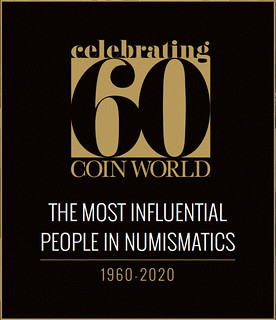 Last October I reviewed the list of about two hundred people under consideration by Coin World for their
list of The Most Influential People in Numismatics. I added more than fifty names to my listing of
American Numismatic Biographies (ANB) although I thought some of them were weak candidates.
Last October I reviewed the list of about two hundred people under consideration by Coin World for their
list of The Most Influential People in Numismatics. I added more than fifty names to my listing of
American Numismatic Biographies (ANB) although I thought some of them were weak candidates.
Last Wednesday I received the issue with the 96 people selected. I went through the statements and made about 400 revisions to ANB based on those statements. There were a couple of names I did not recognize and about five people who were not already in ANB. I will not be adding them.
There are people on the list who have never written a book, never had an article published, never held an office in a coin club, never made an educational presentation at the ANA and never received an award from a numismatic organization.
In my opinion, buying and selling coins in the numismatic market does not make someone influential. That would still be true when the coin value is in seven figures. I have more respect for the people on the list who have never been a dealer but who have contributed to our knowledge.
Then I noticed something interesting. Some of the people I don't know place regular full-page ads in Coin World. A typical recent issue has eleven full page ads. Each of those companies is represented by one of the influential numismatists. The eleven ads represent thirteen people on the list. Some of those are very deserving, but some, in my opinion, are not.
I believe the list is worthy of discussion and I would be interested in comments from other readers.
Such lists are always open to interpretation and suggestions. Plenty of worthy candidates won't make the cut and that's always unfortunate. Similarly, some included candidates will certainly prompt questions. Only Coin World can address the criteria used for their list. -Editor
To read the earlier E-Sylum article, see:
THE MOST INFLUENTIAL PEOPLE IN NUMISMATICS
(https://www.coinbooks.org/v24/esylum_v24n17a22.html)
ANSWER: "I.G." ON MARYLAND COLONIAL NOTE
Regarding last week's reader question about the notation "1 G" on an April 10, 1774 Maryland 2/9 of a dollar colonial note Paul Horner writes:
"I do not think "1 G." is a denomination. I believe it may be the engravers initials: I G and not 1 (one) G.
"Newman says these were printed by Anne Catherine Green and Frederick Green. Perhaps "I G." was a son or relative that engraved the plates.
"OR: is "G" an obscure abbreviation for shilling? "1 G." would work if that was the case. If it is, I can find no reference to it."
John Kraljevich writes:
"IG is the initials of Jonas Green, who was the printer of Maryland paper money when those edge cuts were produced. His wife and sons continued the family business after his death."
John Bolger writes:
"The initials I.G. ("eye gee" not "one gee") stand for the original note printer and newspaperman Jonas (Ionas) Green. He died in 1767 but the printing continued under his widow, Anne Catherine Green and son, Frederick Green. The continuation of his ghostly initials after his death may represent another form of anti-counterfeit "secret mark" started with his earlier notes."
Bill Allen writes:
"IG are initials for Jonas Green, Maryland's paper currency printer. IG appeared in the margin of the 1767 two-ninths dollar notes. See the "Colonial Issue of 1770" in this article. (about half way thru the PDF — the pages are not numbered). Jonas died in 1767, but his widow Anne Catherine Green took over the print shop and may have used the same plates for the 1774 issues."
To read the earlier complete article by John E. Sandrock, see:
MARYLAND COLONIAL AND CONTINENTAL BANK NOTE ISSUES OF THE
AMERICAN REVOLUTION
(http://www.thecurrencycollector.com/pdfs/Maryland_Colonial_and_Continental_Bank.pdf)
Thanks, everyone! -Editor
To read the earlier E-Sylum article, see:
QUERY: "1.G." ON MARYLAND COLONIAL NOTE
(https://www.coinbooks.org/v24/esylum_v24n17a15.html)
NOTES FROM E-SYLUM READERS: MAY 2, 2021
Copper 1794 Dollar Pattern SalesDave Hirt writes:
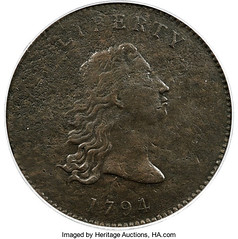 "Another great issue as always. The news of the sale of the 1794 no stars pattern dollar was quite interesting to me. $840,000! The Pollock book of US Patterns lists the previous sale of that coin in 1989 as $21,000. Wow, what a way to invest your money, as well as pride of ownership of a unique coin. The consigner had to be all smiles!
"Another great issue as always. The news of the sale of the 1794 no stars pattern dollar was quite interesting to me. $840,000! The Pollock book of US Patterns lists the previous sale of that coin in 1989 as $21,000. Wow, what a way to invest your money, as well as pride of ownership of a unique coin. The consigner had to be all smiles!
"I was looking at the list of the former owners of the coin. It seemed curious to me that in 1890 it changed hands two times within six months, both times by the same company, New York Stamp and Coin. I pulled my catalog of the R. Coulton Davis sale, Jan. 1890. The obv. of the coin is plated on plate 3, but the plate is rather dark. David Proskey described the coin as "good for the period, unique." The coin realized $35. The buyer's name is listed as Lelay. I do not recognize that name. It may be in code. Just thinking, perhaps Parmelee was not the buyer, but another who returned the coin to NY because of condition. Then Proskey put the coin in the Parmelee sale in June 1890. He changed his description a bit to say "planchet not smooth." , which is consistent with the Heritage description as "excavated at the mint." The coin realized $20 in the Parmelee sale."
Thanks! It's always interesting to trace the provenance of a coin and see whose hands it passed through over the years. Does "Lelay" ring a bell for anyone? I've come up empty in the Newman Portal. -Editor
To read the earlier E-Sylum article, see:
COPPER 1794 DOLLAR PATTERN PUBLICITY
(https://www.coinbooks.org/v24/esylum_v24n17a24.html)
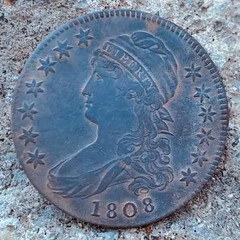 Regarding the variety of the 1808 Half Dollar found while searching for one of Harriet Tubman's homes,
Brad Karoleff writes:
Regarding the variety of the 1808 Half Dollar found while searching for one of Harriet Tubman's homes,
Brad Karoleff writes:
"Looks like obverse 4 to me which would make it an Overton 104."
Thanks! -Editor
To read the earlier E-Sylum article, see:
COIN FIND LEADS WAY TO TUBMAN SITE
(https://www.coinbooks.org/v24/esylum_v24n17a26.html)
Special, or Limited Edition Red Books
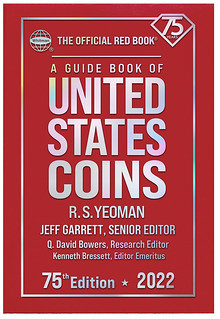 Bill Seldon writes:
Bill Seldon writes:
"Seeing as it's the 75th anniversary of the Red Book, I wondered if you could poll your subscribers to see if anybody has an updated list of Special, or Limited Editions. The trail ends for me in 2009 when Frank Colletti's "A Guide Book of The Official Red Book Of United States Coins" was published. I really wish Frank or someone else would update this book."
I reached out directly to Dennis Tucker at Whitman Publishing. -Editor
Dennis writes:
"In Ken Bressett's upcoming A Penny Saved: R.S. Yeoman and His Remarkable Red Book we have a current listing of all Red Books including Limited Editions.
"Frank Colletti's Guide Book of the Official Red Book of United States Coins goes into more depth as an edition-by-edition study . . . although, as Mr. Seldon notes, its coverage ends in 2009.
"We do get quite a few queries from collectors who want an updated second edition of Frank's book. Pressure is building! I'll keep you and the NBS posted as we consider how to make that happen."
To read the earlier E-Sylum article, see:
NEW BOOK: GUIDE BOOK OF U.S. COINS, 75TH ED.
(https://www.coinbooks.org/v24/esylum_v24n11a02.html)
From the Mountains of North Georgia, Harold Leviwrites:
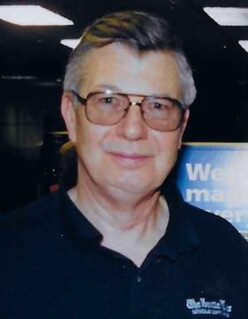 "I was saddened to hear of Bill McKivor's passing. I never actually met Bill, but he and I transacted some business several years ago (2010) while I was deep into the Confederate Cent.
"I was saddened to hear of Bill McKivor's passing. I never actually met Bill, but he and I transacted some business several years ago (2010) while I was deep into the Confederate Cent.
"As a part of his business, Bill had purchased some amount of the British coins Robert Bashlow had gathered in his business. As a part of this, Bill had possession of several of the thin Bashlow Restrike Confederate cent pieces as well as a couple of the new Confederate cent pieces Bashlow and David Latise had made in London. He made me a great offer and I bought all.
"My sincere condolences to his family. It is a little unsettling to find he and I were born in the same year."
Thank you - great story; interesting connection. -Editor
To read the earlier E-Sylum article, see:
WILLIAM JON MCKIVOR (1940-2021)
(https://www.coinbooks.org/v24/esylum_v24n17a07.html)
Ken Berger writes:
"Regarding Ken Spindler's article about the holed Eight Reales coins. In The E-Sylum: Volume 11, Number 14, April 6, 2008, Article 11, you will find an article (More on Arras Tokens) by me explaining some of the reasons as to why the coins contain holes."
Thanks. Here's Ken's description. See the article linked below for the initial discussion. -Editor
"Yes, it is true arras are found in many weddings which have a Spanish tradition. I disagree however that they are always gold coins. The Philippines, for example, used silver coins. In the past these were primarily pesos.
"The coins are supposed to be dropped from the groom's hands into the bride's hands in a 'more or less' cascading action. However, if any of the coins are dropped then bad luck is believed to be likely to occur in the marriage. In order to prevent such bad luck from occurring, the coins often had a hole drilled into them so a string could be passed through them & they could be tied together. These coins were to help the new couple with expenses as they started their life together. It is also possible that they were used as the lucky coins, one of which would be placed under each of the main pilings at each of the four corners of their newly-built house.
"Thus, crown-sized coins with holes in them were possibly used in arras. However, it is also possible that they were worn as a piece of jewelry, or even served as teething rings.
Ken adds:
"I've thought of making an arras with 13 holed 8 Reales coins."
"Regarding "The Holiest Coin Collection," Robert Hoge's article in The Numismatist of June, 1997 concerned a donation to the ANA Museum, of US small cents 1857-1879 gathered by a Pennsylvania farmer who pulled them from circulation, holed each one, and nailed each to his kitchen's wall. (The farmer died in early 1880.) "The front cover has a photograph of one of the coins."
Cringeworthy for collectors, but interesting nonetheless. Thanks. -Editor
To read the earlier E-Sylum articles, see:
ARRAS TOKENS DEFINED
(https://www.coinbooks.org/esylum_v11n13a24.html)
MORE ON ARRAS TOKENS
(https://www.coinbooks.org/esylum_v11n14a11.html)
NOTES FROM E-SYLUM READERS: APRIL 25, 2021 : The Holiest Coin Exhibit
(https://www.coinbooks.org/v24/esylum_v24n17a14.html)
In response to a reader's question Pete Smith submitted these notes clarifying the difference between photos and portraits of early American coin collector Isaiah Quinby Lukens of Philadelphia. Thanks. -Editor
There are at least four known pictures of Isaiah Quinby Lukens, two paintings and two daguerreotypes. The two daguerreotypes may be found among the image files at the Library of Congress.
The first of these is attributed to photographer Robert Cornelius and taken about 1840-41. It can be identified by the oval mat around the image.
The second was taken in 1842 and attributed to Paul Beck Goddard. It has an octagonal mat around the image.
The image in the octagonal mat has been cropped into rectangular format and reproduced on at least three websites.
1. Numismatic Mall.com, undated. Attributed as [Fig, 1 Daguerreotype taken by Charles Wilson Peale].
2. True West Magazine, article dated October 19, 2015. Attributed to "Charles Wilson Peale / Courtesy Library of Congress."
3. Colonial Quills, article dated February 28, 2018. Image attributed as "Isaiah Lukens daguerreotype by Charles Wilson Peale.
All three have the middle name of Peale misspelled. Item #2 is a smaller image so it could not have been the source for #1 or #3. Since #3 is dated after #2, it could not have been the source. It looks like #1 was the source or there was another unidentified earlier source.
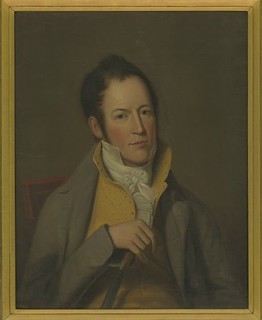 There are two oil paintings of Lukens. The first is dated about 1800 when Lukens was just 21 years old. It is attributed to one of the Peale family.
There are two oil paintings of Lukens. The first is dated about 1800 when Lukens was just 21 years old. It is attributed to one of the Peale family.
Then there is the missing link, a painting of Lukens done by Charles Willson Peale in 1816. It is located at the Franklin Institute in Philadelphia. Unfortunately, I could not find an image online.
Any Google search for the Peale painting will turn up links to the other three images. Errors on the internet are frequently compounded through repetition. Once the Peale painting was confused with the Lukens photo, the error was repeated on the internet and this month in The E-Sylum.
To read the earlier E-Sylum article, see:
ISAIAH QUIMBY LUKENS (1779-1846)
(https://www.coinbooks.org/v24/esylum_v24n15a17.html)
NOTES FROM E-SYLUM READERS: APRIL 25, 2021 : Isaiah Quimby Lukens Photo Question
(https://www.coinbooks.org/v24/esylum_v24n17a14.html)
Bob Rhue writes:
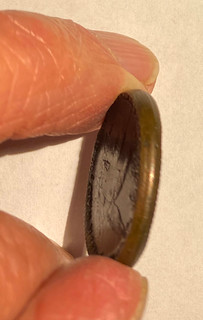 "I bought this unusual Mott token long ago from colonial dealer Tom Rinaldo.
"I bought this unusual Mott token long ago from colonial dealer Tom Rinaldo.
"It comes on an extremely constricted planchet, with a diameter ranging from 5.0 to 5.4 mm. Normal diameter is 6.7 mm.
"The Central portion of the thick Edge is raised around its entire circumference, sloping downward toward the rim on each side.
"Because the peripheral lettering on both sides is sharp and undistorted yet significantly higher than the plane of the rest of the coin, my conclusion is that the planchet was upset subsequent to striking rather than prior to. In any event it seems clear that the bars used in the upsetting process were spaced much too closely during the production of this particular piece.
"I welcome the opinion of others here. "
Interesting item. What do readers think? -Editor
MORE ON THE MONNERON 2 SOL PATTERN PIECE
Two weeks ago Jim Duncan asked,
"Can any of your many contacts provide a reproducible pic of a Monneron 2 Sol pattern piece (that's Hercules / Pyramid)? I'm a collector in NZ who cannot find one on the web..."
I didn't manage to compile responses until now, but Ken Spindler was able to provide an image and much more. Thanks! Here's Ken's response. -Editor
I collect French Revolution coins and currency and tokens, I suppose with a specialization in Monneron pieces, since I now own every variety (except another pattern that I've never seen for sale), + contemporary gold- and silver-plated ones (they were used as gifts), and the Monneron medallic pieces, in original bronze and gilt. And a gorgeous specimen proof. Over the years, I've seen many of these for sale, at least by French auction houses. This is a copy of one of several examples from the archives of iNumis:
There is also a book specifically on the subject of Les Monnerons:
There is also a book specializing in the French Revolution token coinage, overall:
Jim agreed that this is the piece he'd been looking for. -Editor
Jim writes:
"I have seen another but it lacked the owl and I think it a fraud. Many thanks for your prompt response."
In post-revolution France the state coffers were empty and the overissuance of paper money caused inflation and led to the disappearance of coinage from commerce. To address the small change shortage, private entrepreneurs put copper coins into circulation. Paris merchants the Monneron brothers contracted to have pieces of 2 and 5 sols made in England by Matthew Boulton.
Thanks, everyone! Interesting piece. -Editor
To read the earlier E-Sylum article, see:
NOTES FROM E-SYLUM READERS: APRIL 18, 2021 : Monneron 2 Sol Pattern Piece
(https://www.coinbooks.org/v24/esylum_v24n16a14.html)
QUERY: SHAGIN JOHNSON MATTHEY SILVER ROUNDS
Christopher Fleming has a question about Johnson Matthey silver rounds. I can't help, but perhaps one of our readers can. -Editor
 Greg Burns from The California Numismatist sent me your way to ask a question that I have. I have just recently acquired three Johnson Matthey one ounce .999 silver rounds minted in 1986 from what looks to be the "Liberty Series Centennial Anniversary of the Statue of Liberty" plaque that the Ellis Island Foundation had commissioned sculptor Alex Shagin to do. I have never seen these bullion rounds before and I was hoping maybe you had some information about them.
Greg Burns from The California Numismatist sent me your way to ask a question that I have. I have just recently acquired three Johnson Matthey one ounce .999 silver rounds minted in 1986 from what looks to be the "Liberty Series Centennial Anniversary of the Statue of Liberty" plaque that the Ellis Island Foundation had commissioned sculptor Alex Shagin to do. I have never seen these bullion rounds before and I was hoping maybe you had some information about them.
I have found a few articles on Alex Shagin and the plaque he had done and discovered it is featured on the cover of "The California Numismatist" winter 2008 edition. I have seen plenty of other types of Johnson Mathey Liberty rounds and bars and thanks to Allengelhard.com estimated mintages and other information, however, I cannot find anything about these rounds.
If you have any information about JM working with Mr. Shagin, estimated mintage numbers for this round, etc. It would be greatly appreciated.
As always, readers can click on the images to see larger versions on our Flickr archive. Can anyone assist? Thanks. -Editor
To read the California Numismatist issue on the Newman Numismatic Portal, see:
The California Numismatist (Winter 2008)
(https://nnp.wustl.edu/library/book/572556)
VOCABULARY TERM: DRAWINGS AND SKETCHES
Here's another entry from Dick Johnson's Encyclopedia of Coin and Medal Terminology. -Editor
Drawings and Sketches. The earliest concepts of a design recorded in some way as a plan to be developed further. The first ideas of a numismatic or medallic design are usually in the two-dimensional form of a drawing before the design is rendered into a three-dimensional form, either of which is called a study. Often a great number of drawings are made (if small and sketchy they are called thumbnail drawings); the artist will proceed until a concept for the design is chosen. The process in the mind of the artist is often one of trial and selection, with those having merit being recorded in a drawing, and others discarded.
Some medallic designers, notably Augustus Saint-Gaudens, omitted drawings, instead he prepared sketches directly in clay or plaster, perceiving the three-dimension form in their mind, recording these quickly in some rapidly shaped media as a preliminary design draft to be refined later by further development of the design (once the form is satisfactory then detail, lettering and such is added to finalize the design). Collectors and museums often find interest in these drawings and sketches, including the rejected designs. These early drafts are sometimes exhibited, along with the completed medallic object, to form a design history of how the medallic design evolved. See design.
 I wasn't able to quickly find many images of Saint-Gaudens clay sketches (certainly not for numismatic designs), but this paper discusses four studies for the Robert Gould Shaw Memorial.
-Editor
I wasn't able to quickly find many images of Saint-Gaudens clay sketches (certainly not for numismatic designs), but this paper discusses four studies for the Robert Gould Shaw Memorial.
-Editor
For more information, see:
Model Citizens: Four Studies for Augustus Saint-Gaudens's Robert Gould Shaw Memorial
(https://www.jstor.org/stable/26378748)
To read the complete entry on the Newman Numismatic Portal, see:
Drawings and Sketches
(https://nnp.wustl.edu/library/dictionarydetail/515798)
SAMUEL BIRCHALL (1761-1814)
Here's a biography of early British coin collector and numismatic author Samuel Birchall by Peter Preston-Morley of Dix Noonan Webb. See an article elsewhere in this issue to learn more about DNW's upcoming sale of Birchall's 240-year old collection. -Editor
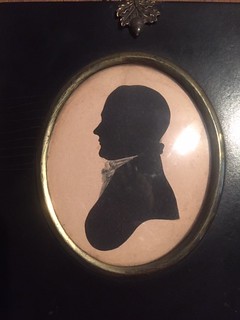 Samuel Birchall, one of five children of Caleb Birchall (1735-1805), of Rainford, Lancashire, and his wife Mary, née Stapleton (1739-1802), was born into a Quaker family in Horsehay, Shropshire, on 31 May 1761. He was a pupil of George Bewley's school in Kendal from 1773 to about 1777. The family moved to Stockport, Cheshire, in the summer of 1779, where his parents ran a calico and tea business. He married Anna Jowitt (1765-93) on 6 June 1785 and the following year moved to Leeds, where he joined his wife's family firm, John & Joseph Jowitt, woolstaplers, in which Samuel had become a partner by June 1788. Samuel occupied himself with civic duties in his newly-adopted home town. He served on the board of governors of Ackworth School and of the Infirmary, was a collector of rates, taxes and duties for the south Division of Leeds and was a trustee of the Workhouse.
Samuel Birchall, one of five children of Caleb Birchall (1735-1805), of Rainford, Lancashire, and his wife Mary, née Stapleton (1739-1802), was born into a Quaker family in Horsehay, Shropshire, on 31 May 1761. He was a pupil of George Bewley's school in Kendal from 1773 to about 1777. The family moved to Stockport, Cheshire, in the summer of 1779, where his parents ran a calico and tea business. He married Anna Jowitt (1765-93) on 6 June 1785 and the following year moved to Leeds, where he joined his wife's family firm, John & Joseph Jowitt, woolstaplers, in which Samuel had become a partner by June 1788. Samuel occupied himself with civic duties in his newly-adopted home town. He served on the board of governors of Ackworth School and of the Infirmary, was a collector of rates, taxes and duties for the south Division of Leeds and was a trustee of the Workhouse.
The Birchalls had five children: Maria, later Eveleigh (1786-1867), Samuel Jowitt (1788-1854), Edwin (1789-1877), Amelia, later Miller (1790-1866) and Alfred (1791-1853). The family lived firstly in Briggate, then Simpson's fold (October 1790), Hunslet lane (July 1794), South parade (May 1811) and 9 Park square (November 1813); Samuel's name is included in ‘Early Leeds Printers', a list of members of the printing and book trade in Leeds compiled by Elizabeth Parr in 1973, and there is a short biographical note on him in Biographia Leodiensis by Richard Vickerman Taylor (London and Leeds, 1865). Following his wife's death on 11 February 1793 at the age of 28, and Samuel's difficulty in finding a housekeeper to look after five children under the age of 7, the children went to stay with their grandparents in Stockport for several months, where the older ones went to school. Writing to Samuel in November 1793, Caleb Birchall said ‘the Shopkeepers here [Stockport] continue to refuse the several sorts of Halfpence [tokens] as when I was at Leeds, but I and many or most others continue to take them tho' we are greatly overdone with them.'
But this is far from the first reference to Birchall and numismatics. Perhaps the inspiration for Birchall's involvement with ‘provincial coins' was the appearance in his home town of the 1791-dated halfpence of Richard Paley (1746-1808), a soap-boiler and chandler turned speculative property developer. On 6 July 1791 Richard Phillips (Samuel's friend Dickey Phillips, with whom he was at school in Kendal) wrote to him from Shrewsbury to advise that he was trying to obtain for Birchall one of the Wilkinson silver tokens, but they were difficult to find. 'Surely if a piece of silver of about the value of half a Crown can be so easily disposed of for 3/6, it would pay him [Wilkinson] to issue a second impression', wrote Phillips.
On behalf of a local business consortium fronted by the Briggate-based jeweller and watchsmith Henry Brownbill (1746-1803), Samuel Birchall wrote to Matthew Boulton at the end of 1792, requesting an order of tokens (left), ostensibly to represent the city's wool trade. The order coincided with a slack period at Boulton's manufactory and, following an exchange of correspondence in which it would seem that Boulton's image of Bishop Blaize used on the Cronebane tokens of 1789 was not preferred by Birchall because he did not want to appear to be authorising the copying of another issuer's imagery, the tokens were quickly produced in the Spring of 1793. Birchall soon became a regular customer of Boulton, ordering special strikings of Soho mint products for several years, always paying promptly.
Samuel Birchall, ardent naturalist and antiquarian, is best known among present-day numismatists for his A Descriptive List of the Provincial Copper Coins or Tokens issued between the Years 1786 and 1796, an alphabetical reference to pieces in his own collection and those of a small number of other contemporaries, including Evesham's MP Thomas Thompson (1767-1818), the Bath grocer Lacon Lander Lambe who later emigrated to Washington, USA (1770-1860) and the London antiquarian Sarah Sophia Banks (1744-1818). The List was printed by Thomas Gill in Leeds and privately published by Birchall in early 1796, at the height of the collecting mania for such items. Painstaking but relatively unsophisticated by present-day standards, Birchall listed over 1,000 different tokens and associated items, products of the new factories in Birmingham and elsewhere. Among them is the private token that Samuel himself put out in 1795 (previous page, centre), the dies engraved by ‘Wyon' although, from the huge range of edge inscriptions employed at the time and in subsequent years, their manufacture would appear not to have been confined to Boulton's emporium.
Apart from tokens, Samuel Birchall formed valuable collections of British gold and silver coins, stuffed birds and beasts (these were sent to London for sale at the end of 1813, following the move to Park square), and mineralogy, maintaining extensive acquaintances with men of letters interested in similar pursuits in other parts of the country. Doubtless one of the sources for the coin collection was the dealer Henry Young (c. 1738-1811) of Ludgate street, London, a token issuer himself in 1794 who was followed in business by his much better-known son, Matthew Young (1770-1838), issuer of his own private token in 1798 and a collaborator with Birchall on his List, for which Henry Young was the retail outlet.
Birchall was closely associated with the very important hoard of about 270 English and Anglo-Viking coins of the early 10th century, found in a decomposed leaden box on land farmed by Benjamin Wright and belonging to Henry Cholmley of the Lobster House, close to the boundary between the parishes of Bossall and Flaxton, seven miles east of York, on 14 September 1807. In discussing the coinage of Regnald, prevalent in the hoard, the late Christopher Blunt and Lord Stewartby refer to coins of this ruler in the Birchall collection (NC 1983, pp.146-63), to which the reader is referred for more background.
Samuel took ill in March 1814 and died at the age of 53 after an attack of gout on 17 May 1814. He was interred on 22 May at the Friends Burial Ground, Camp lane court, Leeds.
The following 148 lots may be said to fairly represent a gentleman's cabinet of British hammered silver coins, from the mid-9th century up to the change in coin production in the early 1660s, of the type formed over 200 years ago. Although living over 200 miles from London and the centre of the then coin trade, Samuel Birchall's contacts, with the Youngs and others, ensured that he would have been kept informed of the availability of specimens he lacked; doubtless he was also aware of the dispersal of the cabinets of the likes of Richard Southgate (1795) and Samuel Tyssen (1802), among others passing through the salerooms at the time. A prompt payer, which Birchall was known to be, additionally made him a valuable customer to the dealers of the day, and he was known to journey to London and other cities on business, where he would have been able to indulge his various hobbies and pursuits.
It is truly exceptional for a private collection made over 200 years ago, and unseen by all but a tiny number of scholars since, to come to today's international coin market. Apart from one (or possibly two) coins from the Bossall/Flaxton hoard (Lots 2-3), there is a notable Harold II penny by the Lincoln moneyer Ulf (Lot 12), representative issues of the early Norman kings including a Profile Left penny of Romney (Lot 13), in all likelihood a stray from the Denge Marsh (Kent) Hoard of 1739, an attractive vis-à-vis shilling of Philip and Mary (Lot 68), a superb Briot milled sixpence (Lot 115) and, perhaps most remarkable of all, a tiny late Declaration penny of Charles I (Lot 126). Coins with a Birchall provenance will be sought after in years to come – enjoy them now via the pages of this catalogue.
Click the link below to view the lots in Samuel Birchall's collection:
British Coins from the Collection of Samuel Birchall of Leeds (1761-1814)
(https://www.dnw.co.uk/auctions/catalogue/results.php?auction_id=593&specialcollectionpart_id=1214)
DAVID ULYSSES PROSKEY (1853-1928)
Here's another entry from the online draft of John Lupia's book of numismatic biographies. Thanks! This is an excerpt with the full article and bibliography available online. This week's subject is dealer David Proskey. -Editor
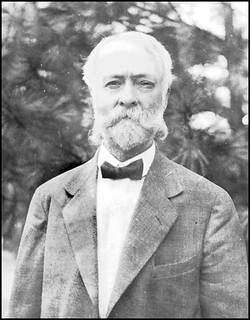 David Ulysses Proskey (1853-1928), was born the eldest of eight children, and first of five sons, on December 12, 1853, son of Sigismond Proskey (1837-1898), a Pollock and prosperous merchant by trade, and his mother born in Glasgow, Scotland of Irish parents, Anna "Jane" Josephine Lynch Proskey (1836-1898), at Wappinger Falls, Duchess County, New York. His father seems to have been educated in classics since he names his son Alexander and David's middle name is Ulysses.
David Ulysses Proskey (1853-1928), was born the eldest of eight children, and first of five sons, on December 12, 1853, son of Sigismond Proskey (1837-1898), a Pollock and prosperous merchant by trade, and his mother born in Glasgow, Scotland of Irish parents, Anna "Jane" Josephine Lynch Proskey (1836-1898), at Wappinger Falls, Duchess County, New York. His father seems to have been educated in classics since he names his son Alexander and David's middle name is Ulysses.
David Proskey is a very interesting personality in American numismatic history. Coming from a large family of industrious businessmen he had his hand in several prospects at any given time. His is a story of a young man whose hobby brought him fame and fortune over time. In the beginning he was probably involved in the Proskey Brothers mainly as an investor when his brother Alexander began a lumber business in Paterson, New Jersey, also the site where they lived. The Proskey Brothers soon became a building company, hoteliers, and then real estate brokers making many transactions over the years and a substantial fortune for the family. But, in the beginning David soon spread out to New York with an office selling stamps, coins, minerals, curios, and other antiquities. Keeping his own office he put his younger brother Samuel there after he had graduated from school during the day when he went off to work for John Walter Scott. In the evenings both would travel back home by train. Proskey probably edited Scott's Coin Collector's Journal from his own business office on many occasions but also appears to have had other duties managing the coin and medal department for Scott requiring his presence there.
Scott more and more began to be overwhelmed dealing in stamps. Proskey was also well versed in stamps and was a big help to Scott as his business grew. Undoubtedly, the growth of Scott & Company can to some extent be attributed to the hard work of Proskey, which eventually led to Scott selling out to a syndicate controlled by the Calman Brothers and Henry Collin. It was because of the talent and energy of David Proskey capitalized by Scott that John W. Scott was dubbed the octopod by Frossard since he seems to have had his hands in everything working at ferocious speed dominating the markets of coins and stamps. All the while David Proskey built up his own businesses. He became established as a leading dealer in stamps and coins but more and more over time migrated to coins in the later 1890's due to the synergy of Harlan Page Smith, a financier who may have been involved with the Proskeys in their other business ventures as well.
1. The First Period - 1873-1878.
In 1873, he began selling stamps, coins, minerals and curiosities at the behest of his parents who complained of the enormity of his collection cluttering the house.
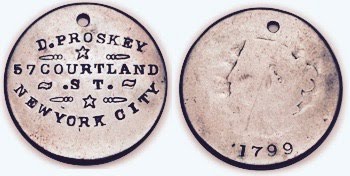 Fig. 2. Store Card of David Proskey, 57 Courtland St., New York City counterstamped on a pierced worn out and redated Coronet Type -Matron Head Large Cent to amuse a collector with the wishful date newly engraved of 1799. EX-Presidential Coin & Antique, Token & Medal Auction Sale, No. 26, May 26, 1979, Lot 1629.
Fig. 2. Store Card of David Proskey, 57 Courtland St., New York City counterstamped on a pierced worn out and redated Coronet Type -Matron Head Large Cent to amuse a collector with the wishful date newly engraved of 1799. EX-Presidential Coin & Antique, Token & Medal Auction Sale, No. 26, May 26, 1979, Lot 1629.
In 1875, He lived at 186 Washington Street, New York. At as Emmanuel Joseph Attinelli tells us that time he printed a small circular selling the Centennial Medal of the 7th Regiment N. G. visit to Boston, Massachusetts.
In 1876, Proskey was located at 194 Washington Street, New York City.
In the April 1878 issue of American Journal of Numismatics, Proskey advertised his own business at 765 Broadway, stating that he was a dealer in "coins, medals, tokens and numismatic works. Masonic, Centennial, Washington, Lincoln, Hayes, and Tilden, a specialty. Rare store cards and political medals. Forty-four page Illustrated Catalogue of United States, foreign and ancient Roman silver coins, sent postpaid for 25 cents."
Proskey was both a dealer and a collector who held several coin auction sales from 1876 to 1887 prior to his numismatic business partnership with Harlan Page Smith. The exact number of auction catalogues made by David Proskey is unclear but he may have produced sixty-five or more under his own name, Scott & Co., Scott Stamp & Coin Co., Ltd, and New York Coin and Stamp Co., as well as for others.
There is much more about Proskey's lengthy numismatic career in the complete article online. I'll excerpt some more next week. -Editor
To read the complete article, see:
PROSKEY, DAVID ULYSSES
(http://www.numismaticmall.com/numismaticmall-com/proskey-david)
MINT ENGRAVER T. JAMES FERRELL
Dave Bowers published a nice Stack's Bowers blog article this week on Mint Engraver T. James Ferrell. That's Dave's portrait below, not that of Ferrell. -Editor
Born in Clayton, New Jersey in 1939, T. James Ferrell graduated from the Pennsylvania Academy of Fine Arts, where he pursued studies in painting, sculpture, and graphics. Upon leaving art school in 1963, he worked as an artist on the staff of the Philadelphia Evening Bulletin for six years. In the decade after his graduation he served as monitor of the Professional Artists' Graphic Workshop at the Academy. He studied art at the Barnes Foundation in Merion, Pennsylvania for two years.
Ferrell is a recipient of the Cresson European Traveling Scholarship, the Charles Toppan Prize for oil painting, and for four consecutive years the Lux prize and the Woodrow prize in printmaking. Many institutions and galleries have exhibited his work.
In 1969 he became interested in the new Franklin Mint and joined the staff of medallic artists there, working under Gilroy Roberts, who had earlier served as chief engraver of the U.S. Mint. After a very productive five years designing coins (for foreign countries including Panama, the Philippines, and Egypt) and medals, he became part of management but still worked with artistic concepts in the sculpting and design of hundreds of medals. During his 20-year tenure with the Franklin Mint, he developed an expertise and technical knowledge in the production of coins and medals.
In August 1989 he joined the Engraving Department of the United States Mint in Philadelphia where he sculpted more than 30 coins. One of his early projects was the creation of the Congressional gold medal honoring Jesse Owens, followed in late 1990 by the design of the reverse of the 1991-dated Mount Rushmore commemorative half dollar, and in 1991 by the reverse of the Korean War commemorative silver dollar.
He modeled five Washington quarters in the State Series and over 30 commemorative coins from 1990 to 2004. Some commemoratives include the 1992 Columbus Quincentennial commemorative half dollar obverse, the 1993 Jefferson 250th Anniversary commemorative silver dollar, the 1997 Franklin D. Roosevelt Memorial gold half eagle obverse, the 2002 United States West Point Bicentennial commemorative silver dollar obverse, and the 2003 Wright Brothers commemorative silver dollar obverse.
While there was no chief engraver during this time at the United States Mint, T. James Ferrell's light shined as brightly as that of a chief engraver. In 2002 the American Numismatic Association honored Ferrell with its Medallic Sculpture Award.
To read the complete article, see:
Mint Engraver T. James Ferrell
(https://www.stacksbowers.com/News/Pages/Blogs.aspx?ArticleID=mint-engraver-t-james-ferrell-from-the-desk-of-q-david-bowers)
Ferrell passed away in 2020. Here's an excerpt from his online obituary and a link to Dick Johnson's database entry. -Editor
 Thomas James Ferrell Prominent artist and sculptor/engraver Jim Ferrell, 80, died peacefully in his sleep on May 27, 2020. Jim's artistic talent emerged early in life when he won the Hallmark Honors Prize while still a high school student in Clayton NJ. His outstanding athletic performances as both baseball pitcher and football quarterback for the NJ All State Teams won him a scholarship to Duke University which he turned down in favor of one to the Pennsylvania Academy of the Fine arts where he concentrated his studies in painting and printmaking. During his time at the Academy he won the coveted Cresson European Traveling Scholarship and numerous other prizes. He also studied at the Barnes Foundation.
Thomas James Ferrell Prominent artist and sculptor/engraver Jim Ferrell, 80, died peacefully in his sleep on May 27, 2020. Jim's artistic talent emerged early in life when he won the Hallmark Honors Prize while still a high school student in Clayton NJ. His outstanding athletic performances as both baseball pitcher and football quarterback for the NJ All State Teams won him a scholarship to Duke University which he turned down in favor of one to the Pennsylvania Academy of the Fine arts where he concentrated his studies in painting and printmaking. During his time at the Academy he won the coveted Cresson European Traveling Scholarship and numerous other prizes. He also studied at the Barnes Foundation.
After graduating he became a designer/sculptor at the Franklin Mint where he created world currencies including the Balboa gold and platinum coins of Panama, the Philippines and Egypt in addition to countless medals, collectible coins and objects. Chief sculptor for the United States Mint was so impressed with his work that he asked Jim to join the Philadelphia Mint. Jim was well known for his expertise in both design and sculpture and at the United States Mint he created more than 30 coins still in circulation in addition to special memorials and commemorative medals. He also created and sculpted the Congressional Gold Medals honoring Nelson Mandela, Mother Teresa, Ruth and Billy Graham, Pope John Paul ll and Jesse Owens.
To read the complete articles, see:
Thomas James Ferrell 1939 - 2020
(https://obits.nj.com/obituaries/southjerseytimes/obituary.aspx?n=thomas-james-ferrell&pid=196300027)
FERRELL, T. James
(http://www.medalartists.com/ferrell-tj.html)
DENNIS TUCKER NOW A KENTUCKY COLONEL
Congratulations to Whitman Publisher Dennis Tucker on becoming a Kentucky Colonel! Here's the press release, which includes some great Kentucky-related numismatic items as well. -Editor
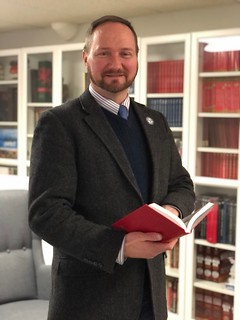 On March 23, 2021, Kentucky governor Andy Beshear commissioned Whitman Publishing's Dennis Tucker as a Kentucky Colonel in recognition of his career in book publishing, and for publicizing and promoting knowledge of the Commonwealth's status as an important subject within American numismatics.
On March 23, 2021, Kentucky governor Andy Beshear commissioned Whitman Publishing's Dennis Tucker as a Kentucky Colonel in recognition of his career in book publishing, and for publicizing and promoting knowledge of the Commonwealth's status as an important subject within American numismatics.
According to the Governor's Office, "The highest honor awarded by the Commonwealth of Kentucky is that of Kentucky Colonel." The Honorable Order of Kentucky Colonels defines the commission as "recognition of an individual's noteworthy accomplishments and outstanding service to our community, state, and nation."
A Career in Nonfiction Publishing Tucker started his career in writing and publications management in New York. In 2004 he was hired as Publisher for Whitman Publishing, LLC, one of the nation's leading publishers of nonfiction books, then headquartered in Atlanta, Georgia. Since then the company has published more than 300 books, including many standard references, relating to the art and science of numismatics (the study of coins and related objects).
Numismatics is a field that touches on all aspects of American financial and banking history, economics, artistry and design, technology, mining and metallurgy, political history, society, and culture. Tucker has also worked on books on the military history of the United States, in particular the Civil War, World War I, and World War II; the American presidency; and the U.S. Army, among other nonfiction subjects.
In his role as Publisher, Tucker has served as Whitman's liaison to the U.S. Treasury Department and its agencies and bureaus including the United States Mint and the Bureau of Engraving and Printing; the U.S. Federal Reserve; the British Royal Mint; the Royal Canadian Mint; Münze Österreich; the Banco de México and Casa de Monedas de México, and other government agencies involved in financial, banking, numismatic, and monetary policy and administration; as well as the congressionally chartered American Numismatic Association, the American Numismatic Society, the Smithsonian Institution, and other nonprofit organizations. He has supported the educational goals of these bodies, and promoted them through the publication of related books.
Numismatic Lecturer and Educator
Tucker has lectured nationwide on the subject of numismatics, on topics ranging from American federal bullion programs to World War I medals, ancient coins, Mexican money, and U.S. paper currency.
He has taught courses on publishing, writing, and research, and has mentored young writers in these fields. He has written hundreds of articles, published nationally, on various numismatic topics, encouraging the study and appreciation of American coins, medals, tokens, and paper money as a way of understanding the history of the United States and the life of its people.
Currently serving his second four-year term as the numismatic specialist on the U.S. Treasury Department's Citizens Coinage Advisory Committee (CCAC), Tucker has advised Treasury Secretaries Jacob Lew, Steven Mnuchin, and Janet Yellen on coinage and medal design.
Kentucky's Role in American Numismatics
There are many numismatic items related to the Commonwealth of Kentucky, including coins, medals, tokens, and paper money.
A popularly collected British token of the 1790s, known as the "Kentucky cent," depicts a pyramid of 15 state abbreviations, with K, for Kentucky, at the top. It has been featured in the Guide Book of United States Coins (the "Red Book") since the first edition was published in 1946.
 The rare and beautiful 1796 P.P.P. Mydellton tokens were made in Birmingham, England, with inscriptions for a proposed British settlement in Kentucky. According to the Whitman Encyclopedia of Colonial and Early American Coins, "Myddelton, an Englishman, acquired a tract of land in northern Kentucky along the Ohio River and sought to create an extensive settlement there to be populated by his countrymen." After having these tokens minted, Mydellton was convicted in London under a 1783 act that prohibited the enticement of craftsmen and artistic workers to emigrate to America. He spent more than three years in Newgate prison, which ended his dream of a new British settlement in Kentucky.
The rare and beautiful 1796 P.P.P. Mydellton tokens were made in Birmingham, England, with inscriptions for a proposed British settlement in Kentucky. According to the Whitman Encyclopedia of Colonial and Early American Coins, "Myddelton, an Englishman, acquired a tract of land in northern Kentucky along the Ohio River and sought to create an extensive settlement there to be populated by his countrymen." After having these tokens minted, Mydellton was convicted in London under a 1783 act that prohibited the enticement of craftsmen and artistic workers to emigrate to America. He spent more than three years in Newgate prison, which ended his dream of a new British settlement in Kentucky.
The Whitman Encyclopedia of Obsolete Paper Money, volume 7, catalogs more than 150 pages of paper currency issued by 162 state-chartered banks in Kentucky. These banks circulated their own legal-tender money from the early 1800s to the late 1860s, and today collectors can acquire hundreds of rare and valuable notes as well as more affordably collectible pieces—some 1,500 types in total. They offer a rich in-depth study of small-town and big-city life in antebellum and Civil War–era Kentucky.
State-chartered banks went federal as American currency started to be nationalized during the Civil War. Many Kentucky banks reorganized to purchase U.S. Treasury bonds as backing and continue to issue their own paper money as National Banks. Nearly 7,000 National Bank Notes are known from 238 charters in more than a hundred Kentucky towns and cities.
Kentucky is well represented in the Guide Book of Civil War Tokens, by Q. David Bowers. During the Civil War, Kentucky merchants issued dozens of types of "storecard tokens"—privately minted bronze tokens used as small change in day-to-day transactions. As the war dragged on, increasingly nervous citizens hoarded their gold coins, then silver, and finally even copper cents, to the extent that for a time there were no legal-tender coins in circulation. Substitutes such as paper chits, encased postage stamps, and bronze tokens filled the daily need for small change. For the merchants who issued them, the tokens also served as little advertisements, promoting their names, products, and locations. Today, Kentucky's Civil War tokens are testaments to the innovation of the Commonwealth's saloonkeepers, grocers, bakers, druggists, ferrymen, manufacturers, and other merchants who issued them.
Later, into the 1930s and beyond, numerous Kentucky merchants used advertising tokens to lure customers in to shop or enjoy a drink, with many tokens marked with "Good For Five Cents in Trade," "Good for One Cigar," and similar enticements.
The United States issued a commemorative silver half dollar, minted from 1934 to 1938, to honor the bicentennial of Kentucky explorer Daniel Boone. The coin shows the famous frontiersman with Shawnee war chief Blackfish.
More recently, the 2001 Kentucky State quarter dollar illustrates Federal Hill—"My Old Kentucky Home"—and a thoroughbred racehorse symbolic of the Commonwealth's famous bluegrass country. And Kentucky's 2016 America the Beautiful quarter dollar celebrates the Cumberland Gap, "First Doorway to the West," embodied by a rifle-bearing frontiersman.
In March 2021 the Citizens Coinage Advisory Committee convened to review and discuss potential designs for Kentucky's "American Innovation" dollar coin, scheduled to be released in 2022. The CCAC's design recommendation to Treasury Secretary Yellen evokes a 45 RPM record, symbolic of Kentucky's bluegrass music and its far reach throughout the country, over radio, and in the recording industry. The image of a record and its label, inspired by Bill Monroe and the Bluegrass Boys' hit song "Blue Moon of Kentucky," is paired with silhouettes of the fiddle's classic f-shaped sound hole.
Tucker's Connections to Kentucky Authors
"My favorite connection to the Commonwealth," Tucker said, "is my friendship and professional collaboration with two Kentucky authors: Jeff Garrett and Michael Moran." Whitman Publishing has published award-winning books by both authors.
Jeff Garrett is the founder of Mid-American Rare Coin Galleries in Lexington; a past president of both the American Numismatic Association and the Professional Numismatists Guild; and a consultant to the Smithsonian's National Numismatic Collection. He has bought, sold, and owned many of the nation's major numismatic rarities.
Garrett is the senior editor of the Guide Book of United States Coins (popularly known as the "Red Book"), which celebrates its 75th edition this year. He is the author of Silver: Everything You Need to Know to Buy and Sell Today. And he has coauthored many books including the Encyclopedia of U.S. Gold Coins, 1795–1933; 100 Greatest U.S. Coins; 100 Greatest Modern U.S. Coins; and United States Coinage: A Study by Type, among others.
Mike Moran is a business executive, numismatic author, lecturer, and researcher, and former chair of the advisory board of the Art Museum at the University of Kentucky. With Jeff Garrett, Moran coauthored 1849: The Philadelphia Mint Strikes Gold, which chronicles the trials and tribulations of the U.S. Mint in the first half of the 1800s and the tremendous impact that the 1848 discovery of gold in California had upon that institution and the nation as a whole.
Moran's book Striking Change: The Great Artistic Collaboration of Theodore Roosevelt and Augustus Saint-Gaudens is a groundbreaking study that explores the renaissance of United States coinage at the beginning of the twentieth century.
Moran is a member of the Citizens Coinage Advisory Committee. He and former CCAC chair Thomas Uram were instrumental in creation and passage of the 1921 Silver Dollar Coin Anniversary Act. The act was introduced by U.S. Representative Andy Barr of Kentucky's 6th District and signed into law this year. It mandates striking of new coins honoring the last Morgan silver dollars and the first Peace silver dollars, both types minted in 1921.
"I'm honored to work with two of Kentucky's finest authors and researchers," Tucker said. "I appreciate the Governor's commission as a Kentucky Colonel, and I look forward to serving the Commonwealth as a goodwill ambassador. I will continue to enlighten people about our nation's rich numismatic history and Kentucky's important place in it."
DNW OFFERS SAMUEL BIRCHALL COLLECTION
Dix Noonan Webb are offering a coin collection assembled nearly a quarter millennium ago. Here's the press release. -Editor
A fascinating collection of British coins that was amassed 240 years ago by Samuel Birchall of Leeds is to be offered in a sale of Coins, Tokens and Historical Medals on Tuesday & Wednesday, May 4 & 5, 2021 by international coins, medals, banknotes and jewellery specialists Dix Noonan Webb.
The collection includes examples dating from the time of Alfred the Great and Harold II with estimates up to £2,000. Samuel Birchall (1761-1814) was a pupil of George Bewley's school in Kendal from 1773 to about 1777. The family moved to Stockport, Cheshire, in the summer of 1779, where his parents ran a calico and tea business. He married Anna Jowitt (1765-93) on 6 June 1785 and the following year moved to Leeds, where he joined his wife's family firm, John & Joseph Jowitt, woolstaplers, in which Samuel had become a partner by June 1788. Samuel Birchall is best known among present-day numismatists for his A Descriptive List of the Provincial Copper Coins or Tokens issued between the Years 1786 and 1796, an alphabetical reference to pieces in his own collection and those of a small number of other contemporaries. Apart from tokens, Samuel Birchall formed valuable collections of British gold and silver coins. Doubtless one of the sources for the coin collection was the dealer Henry Young (c. 1738-1811) of Ludgate street, London, a token issuer himself in 1794 who was followed in business by his much better-known son, Matthew Young (1770-1838), issuer of his own private token in 1798 and a collaborator with Birchall on his List, for which Henry Young was the retail outlet.
As Peter Preston-Morley, Head of Coin Department, Dix Noonan Webb, commented: "The 148 lots may be said to fairly represent a gentleman's cabinet of British hammered silver coins, from the mid-9th century up to the change in coin production in the early 1660s, of the type formed over 200 years ago. Although living over 200 miles from London and the centre of the then coin trade, Samuel Birchall's contacts, with the Youngs and others, ensured that he would have been kept informed of the availability of specimens he lacked; doubtless he was also aware of the dispersal of the cabinets of the likes of Richard Southgate (1795) and Samuel Tyssen (1802), among others passing through the salerooms at the time. A prompt payer, which Birchall was known to be, additionally made him a valuable customer to the dealers of the day, and he was known to journey to London and other cities on business, where he would have been able to indulge his various hobbies and pursuits."
He continues: "It is truly exceptional for a private collection made over 200 years ago, and unseen by all but a tiny number of scholars since, to come to today's international coin market. Apart from one (or possibly two) coins from the Bossall/Flaxton hoard, there is a notable Harold II penny by the Lincoln moneyer Ulf, representative issues of the early Norman kings including a Profile Left penny of Romney, in all likelihood a stray from the Denge Marsh (Kent) Hoard of 1739, an attractive vis-à-vis shilling of Philip and Mary, a superb Briot milled sixpence and, perhaps most remarkable of all, a tiny late Declaration penny of Charles I. Coins with a Birchall provenance will be sought after in years to come."
Also in the sale will be one of the best collections of tokens from Wiltshire to be sold at auction for many years. The collection of 17th century tokens formed by the late Robert Thompson (Part II) includes examples from Devizes, Marlborough, Amesbury, Bradford-on-Avon, Calne, Salisbury, Swindon and Warminster, among others, with estimates ranging up to £300.
A collection of Irish Masonic Pennies is among the 40 lots of Irish tokens from the collection of Belfast-born Barry Woodside (1951-2019). His greatest interest was numismatics, particularly Irish tokens, which began in the early 1980s. Estimated at £800-1,000, this group is probably the best of its kind in private hands. Also of note is an extremely rare 19th century proof silver penny by Edward Stephens of Dublin showing a uniformed bust of Wellington, which is estimated at £500-600.
Elsewhere in this issue we've included DNW's biography of Birchall. -Editor
For more information on the sale, see:
https://www.dnw.co.uk/
ON CONDITION, DAMAGE, AND PRICE
We don't typically discuss grading or valuation, but here's an interesting article by Allan Davisson on the issues involved in triangulating an auction estimate for pieces that exhibit flaws that can detract from market value. Not an easy task. What do readers think? -Editor
How do you value a rare coin with damage? This issue comes up fairly often in the process of cataloging coins for our sales. Damage reduces the value and makes price guides or auction history less relevant. One of the coins offered here illustrates the problem—an exceptional and undamaged portrait on a piece produced by one of the finest medallists of any era on a fresh flan but with clear damage in the field, the Thomas Simon portrait on the hammered shilling of Charles II soon after he returned from exile.
We (Allan catalogued, Lief and Marnie consulted) looked at comparables, considered the overall quality of the piece with other examples and ultimately thought about the appeal of the piece in hand. And we came up with a value that we think takes into account the damage but also recognizes the quality of so much of the piece.
So, a discussion of our thinking….
The grading/slabbing services handling an Uncirculated coin with a problem will give you a grade and a holder but not a number. Bends, bumps, brush marks—any of these are enough to cut deeply into the value of a coin. Grading services such as PCGS and NGC handle such things ("disqualifiers") tersely with a word or two: "cleaned," "tooled," "repaired." Then a "details" grade is given—"Unc details" for example. Normal wear does not draw such condemnation—the sorts of marks and wear that a piece incurs in circulation are in addition to the "details" grade.
Most published price guides in the United States define their columns of values by these numbers. The "disqualifiers" range from trivial to terrible. No price guide could cover such a range of issues.
The classic, non-slabbed approach to grading involves a letter grade and, typically, a comment about any unusual wear and tear (if any) aspects of a piece. A careful description can provide more detail than the single word approach. For example, any indication of a hairline on a coin brings out the "cleaned" designation for a grading service. A written description can be more specific about the extent of the hairlines.
But the point of this brief essay is to deal with the next—and arguably more significant question—what is the effect of damage on the value of the piece? The simple answer is that there is no simple answer (unless desirability is based only on an unsullied numerical grade, but that is a topic for another day).
The shilling in question: When Charles II returned from exile to England the most recent coinage was the plain Commonwealth coinage with all its anti-royal symbolism. Within a month after his entry into London Charles ordered a new coinage with his image. This was a short-lived series. Coining methodology was in transition. Though Thomas Simon would have preferred to use the new technology of the mill, there was not time to set up the machinery and he quickly produced this elegant portrait for dies for hammered coinage. By the end of 1660 this new coinage was minted.
The lack of a mark of value on this issue was not well-received so within a year a second hammered issue appeared briefly followed by a third issue with both the value in the field and an inner circle of beading. By February or March of 1663 milled coinage was produced and John Roettier's artistry replaced Simon's. The portrait remained through the series.
The practical question when cataloging this sale was how to value a piece with an excellent portrait and fully struck clear legends. But there is a problem in the field to the left of the portrait. The damage is obvious but the portrait is intact. The surfaces of the coin are good metal, the toning is pleasing. Three examples we have handled plus one piece sold by DNW in London last December provide some comparisons.
This is the lot in our current sale, estimated at $4000 with an opening value of $3200. It is an appealing piece with a particularly well struck image and legend on good silver with a delightful old tone.
An example without damage sold for £7500 plus 24% (US$12,500) in DNW's December 2020 sale. "Very slightly double-struck, otherwise extremely fine and virtually as made, attractive grey tone over proof-like fields with underlying bloom, an exceptional specimen, very rare." (£4000-£5000) The legend is not quite as clear and the surface seems a bit dull judging by the photograph.
DNW did not respond to my request for permission to use their published image of this particular piece. You can see it on their site here: https://www.dnw.co.uk/auction-archive/lot-archive/lot.php?lot_uid=362885
We sold this example in Auction 32 (2013) for $7000. "Extremely Fine, attractive old toning; full even strike." The legend is clear but not as clear of the edge as one might prefer, and the underlying iridescence somewhat visible on the DNW piece and more visible on the current sale piece is lacking.
This example was sold by us in E-Auction 34 (2020) for $3000. "Extremely Fine, choice coin with attractive light toning over fresh surfaces, some obverse metal surface not fully annealed on the flan before striking." This piece had much going for it but the quality of the image was compromised by the roughness in the metal flan. Some of the annealing failure is evident if you look closely at the fields. The portrait has roughness as well. The price seemed fair—compromises on the portrait but a very presentable flan, clear legends, centering that preserves all the beading around the rim, a five figure coin if only all the portrait detail were present.
This is the Montagu (1896, lot 746) specimen, described as "extremely fine and rare." This is certainly one of the finest known with claims to the finest. Montagu was known for his fierce efforts to have only the best as he formed his historic collection in the late 19th century. In the current market it would not be unreasonable to estimate it at $20,000. It has a pedigree that goes well back into the 19th century. (We handled this in the late 1990's.)
Given all this information, what is this piece with a flan problem not affecting the portrait really worth? If not for the bend, the $12,500 the DNW piece achieved would suggest a value in the same range or possibly more given the quality of the metal and the toning. Other than the damage, everything about the piece is appealing and choice. But in this era where value is so dependent on condition the effect on value is significant. So, the number we finally determined to be a fair valuation in this era of such a strong focus on condition is a third of the recent price achieved in the December London sale.
For more information on the Davisson's sale, see:
https://davcoin.com/
MODERN RARE COINS IN ALBUM AUCTION 40
Here's an additional press release from Stephen Album Rare Coins highlighting some modern rarities in their upcoming Auction 40. -Editor
Alongside the dramatic rise in the price of gold, modern numismatic rarities - those scarce coins minted in the last 50 years - have been emerging in the market. Two such rarities will be offered in the upcoming Stephen Album Rare Coins Auction 40 which takes place May 13-15.
"Our staff has a wide range of knowledge, and because of that, we often find rare items in collections that would have otherwise gone unnoticed. Many modern issues with very low mintages may represent a real opportunity in today's market." says Stephen Album Rare Coins CFO and Director of World Coins Paul Montz.
The first of the two coins, Lot 1657 is a gold 1980 five pound proof coin from Egypt, certified Proof 68 by PCGS. It has a known mintage figure of just 125 pieces.
To read the complete lot description, see:
https://www.sarc.auction/EGYPT-Arab-Republic-AV-5-pounds-1980-AH1400-PCGS-PF68_i40778672
The second notable rarity, Lot 1672 is a gold 2000 sylis of Guinea, certified Proof 68 by NGC. It has a mintage figure of only 50 pieces, with possibly fewer surviving to present-day.
To read the complete lot description, see:
https://www.sarc.auction/GUINEA-Republic-AV-2000-sylis-1977-NGC-PF68_i40778687
Contributing to the overall scarcity of modern rarities, the high price of gold has at times led to these low mintage coins being melted for their precious metal value. The end result is that even fewer coins remain available today compared to the already low original mintages. Those that do represent an incredible value to the knowledgeable collector.
Two lots that were sold in prior Stephen Album Rare Coins auctions attest to the enthusiasm from auction bidders to acquire these rare pieces. The first, a 1982 balboa from Panama, has a mintage of only 50 pieces. The lot opened at $130 and saw a final hammer price of $1,900!
To read the complete lot description, see:
https://www.sarc.auction/PANAMA-Republic-1-balboa-1982-FM-NGC-PF67_i38303861
The second piece, a Costa Rican 250 colones, saw a final hammer price of $1,000 after a starting bid of $280.
To read the complete lot description, see:
https://www.sarc.auction/COSTA-RICA-Republic-AR-250-colones-1983-PCGS-PF68_i38303819
For the coins that are available in the upcoming auction, pre-sale bidding, live bidding and high resolution images can be found at www.sarc.auction
To read the earlier E-Sylum article, see:
STEPHEN ALBUM RARE COINS AUCTION 40
(https://www.coinbooks.org/v24/esylum_v24n17a19.html)
SELECTIONS FROM HOLABIRD MAY 2021 SALES
Here are some lots that caught my eye this week in the upcoming Holabird sale. -Editor
51 mm bronze inaugural medal w/raised bust of Harry S. Truman on Obverse. No obvious scratches or markings. Excellent cond.
Nice medal. -Editor
To read the complete lot description, see:
Bronze Medal of the Truman Inauguration [129916]
(https://holabirdamericana.liveauctiongroup.com/Bronze-Medal-of-the-Truman-Inauguration-129916_i41002341)
Silver Ingot Engraved from Julius A. Turrill to Clayton R Turrill, White River/Pioche Nevada c 1870 5.15 Troy oz silver ingot engraved on one side by the presenter, Juliuys A. Turrill to his nephew, Clayton R. Turrill engraved on a polished surface. 2" x 0.75" wide x 0.5" tall.
See the online lot description for the full research on this great item. -Editor
To read the complete lot description, see:
White Pine Rush Silver Ingot, Turrill, New Discovery [132920]
(https://holabirdamericana.liveauctiongroup.com/White-Pine-Rush-Silver-Ingot-Turrill-New-Discovery-132920_i41002492)
Featured in Holabird's Bottle Book, this piece is an 1875 Liberty Seated obverse, and on the reverse: Nev. S. A. M, & M. S. / Life / J. F. Myers / Member. See Nevada Bottle Book Volume II p221-224 for complete history on this bottle and the Reno drug store merchant John F. Myers who died of a morphine overdose after the sale of his drug store in 1885.
Great piece. -Editor
To read the complete lot description, see:
Engraved Seated Liberty Half Dollar of J. F. Myers, A Reno Druggist [129318]
(https://holabirdamericana.liveauctiongroup.com/Engraved-Seated-Liberty-Half-Dollar-of-J-F-Myers-A-Reno-Druggist-129318_i41002513)
Maria Theresa thaler made into a hinged box for snuff, opium or cocaine. Wonderful conversation piece at a party.
Always interesting. -Editor
To read the complete lot description, see:
Maria Theresa Thaler Opium Box [132046]
(https://holabirdamericana.liveauctiongroup.com/Maria-Theresa-Thaler-Opium-Box-132046_i41002602)
Gem uncirculated Pedley-Ryan & Co. silver dollar, worthy of certification. Obv. Pedley-Ryan & Co. / Denver // Rev. 1933 / Silver / 430 Grains HK-825 Silver. 38mm. Pedley-Ryan & Co., Denver investment house, in order to provide a convenient medium for speculation in silver and to increase the use and popularity of silver as a medium of exchange, started a "Buy-an-Ounce-of-Silver" campaign Jan. 5, 1933. Silver at that time was in very limited demand, bar silver being quoted at 27 cents an ounce.
Very plain, but interesting. -Editor
To read the complete lot description, see:
Pedley Ryan Dollar: HK 825 Type IV [131211]
(https://holabirdamericana.liveauctiongroup.com/Pedley-Ryan-Dollar-HK-825-Type-IV-131211_i41002632)
Obv.: The Will To Achieve / (pictorial pioneer) / Fairbanks 1929; Rev.: Standard Plaza 1963 / Standard Insurance Company Portland, Oregon. Bronze, 68 mm. From Medallic Art.
To read the complete lot description, see:
The Will To Achieve Medal [132115]
(https://holabirdamericana.liveauctiongroup.com/The-Will-To-Achieve-Medal-132115_i41002646)
Showing prices paid by E. F. Gambs Company. 1804 dollar - $500. 1794 half dime $3 in fine condition. Other interesting fun facts include fictitious names for cities (San Francisco, Golden City), Value of Diamonds, First occurrences (first newspaper, 1588 in England), list of the 28 cities with over 100,000 people (ending with Allegheny at 105,287), and fun facts about money (platinum coins were minted in Russia from 1828 to 1845), etc. 5.5x3.5h. 36 pages. Fun history and interesting monetary values.
Great numismatic ephemera. i don't have this one. -Editor
To read the complete lot description, see:
Rare old San Francisco Coin Catalog c1890 [130122]
(https://holabirdamericana.liveauctiongroup.com/Rare-old-San-Francisco-Coin-Catalog-c1890-130122_i41002716)
Unique piece of history. This is a letter from the Carson City Mint secretary L.L. Elwood to R. Keating of The Nevada Bank of Virginia City, confirming a shipment of $2,400 in gold coin via Wells, Fargo Express on February 18, 1892. The note is on Mint of the United States at Carson letterhead.
More great numismatic ephemera. -Editor
To read the complete lot description, see:
Carson City Mint Letter Re: Wells Fargo Shipment of Gold Coins [131776]
(https://holabirdamericana.liveauctiongroup.com/Carson-City-Mint-Letter-Re-Wells-Fargo-Shipment-of-Gold-Coins-131776_i41002719)
THE BOOK BAZARRE
NUMISMATIC NUGGETS: MAY 2, 2021
Here's a selection of interesting or unusual items I came across in the marketplace this week. Tell us what you think of some of these. -Editor
Lot 049. Lydian Kingdom. Kroisos. Circa 564/53-550/39 BC. AR stater. Sardes mint.
Lydian Kingdom. Kroisos. Circa 564/53-550/39 BC. AR stater (19 mm, 10.60 g). Sardes mint. Confronted foreparts of lion right and bull left / Two incuse squares of unequal size. Berk 20; SNG Ashmolean 760. aVF, Lighty toned, test cut.
From the upcoming Agora Auctions sale. -Editor
To read the complete lot description, see:
Lot 049. Lydian Kingdom. Kroisos. Circa 564/53-550/39 BC. AR stater. Sardes mint.
(https://agoraauctions.com/listing/viewdetail/51043)
1786 New Jersey Copper. Maris 17-K. Rarity-3 for the variety, Rarity-7+ overstruck on a 1772-dated REGAL British halfpenny. Very Fine. This is the BILL ANTON specimen, sold as Lot 6034 of the "E Pluribus Unum" collection in November 2019, where it was plated and described as follows:
1786 New Jersey copper. Maris 17-K. Rarity-3. Straight Plow Beam. Overstruck on a 1772 English halfpenny. VF Detail, Environmental Damage (PCGS). 144.7 grains. Dark brown with some darker scale across surfaces that maintain good gloss despite their moderate roughness. Very sharp and fairly attractive. A curved old scrape across the horsehead is the most significant flaw, and others are fairly minor. Though this variety usually comes overstruck, and typically shows a wealth of visible undertype, Connecticut coppers made up the lion's share of the planchet stock. More unusual undertypes are avidly sought, and this 1772 English halfpenny certainly qualifies. The 1772 date — which appears to be from a Tower Mint-struck authentic coin — is clearly visible beneath and left of the 1786 New Jersey date. This positioning hardly seems accidental, though it could be. Strong hints of BRITANNIA are visible with scrutiny, though the reverse scale obscures the traces of the English halfpenny's obverse.
Overstriking on New Jersey coppers is an interesting phenomenon that underscores two facts. First, it was clearly easier (at least some of the time) to acquire copper coins than sheet copper for virgin planchets. Second, those copper coins could be acquired less expensively than the market value of New Jersey coppers in the marketplace. The predominance of Connecticut coppers suggests that they transacted at a discount to New Jersey coppers, but other undertypes are too scarce to draw any reasonably conclusion.
A very rare undertype - struck on a 1772 British Halfpenny. From Jeff Rock's Rosa Americana, Ltd. Fixed Price List #21. To contact Jeff, write to: rosaamltd@gmail.com . -Editor
The 1792 Half Disme is a famous coin from the U.S. Catalog. Though carried in the Colonial Registry, it is among the first federal coins struck for circulation. It is estimated that approximately 100 exist. Many of those are low-grade or damaged.
This particular example is as problem-free as they come, with nice original surfaces. The centering and overall make gives it a bold appearance.
From an email offering by Harry Laibstain Rare Coins. -Editor
For more information, see:
http://hlrc.com/
Often called America's first commemorative coin, the historic importance of the 1848 CAL quarter eagle is undeniable. A total of 1,389 were struck with the first gold sent to the Philadelphia mint by way of the new discoveries in California. This issue is a bit less rare than one might expect due to the fact that, early on, it was recognized as a "special" issue and, as a result, many were saved. Today, there are maybe two dozen+ accounted for in Uncirculated but the majority of these have been put away and off the market.
This coin has been off the market for over a decade and it represents an unusual opportunity for the advanced collector.
A very tasty item found in an email offering from Doug Winter. -Editor
To read the complete item description, see:
ON HOLD - $2.50 - 1848 CAL. PCGS MS62
(https://raregoldcoins.com/rare-gold-coin-inventory/just-added-250-1848-cal-pcgs-ms62)
1980-P 5C Jefferson Nickel -- Struck on Cent Planchet -- MS64 Red and Brown PCGS. From The Don Bonser Error Coin Collection Part III.
From an upcoming Heritage sale. Beautiful coloring. -Editor
To read the complete lot description, see:
1980-P 5C Jefferson Nickel -- Struck on Cent Planchet -- MS64 Red and Brown PCGS.. From The Don Bonser Error .
(https://coins.ha.com/itm/errors/1980-p-5c-jefferson-nickel-struck-on-cent-planchet-ms64-red-and-brown-pcgsfrom-the-don-bonser-error/a/60203-91151.s)
AULERCI CENOMANI GOLD STATER FOUND IN JERSEY
A metal detectorist uncovered a rare gold stater in Jersey. Thanks to Arthur Shippee for passing this along. Found via The Explorator newsletter. To subscribe to Explorator, send a blank email message to: explorator+subscribe@groups.io. -Editor
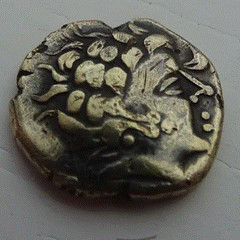 A TWO millennia-old gold coin believed to be one of the finest examples of its kind has been found by a local metal detectorist.
A TWO millennia-old gold coin believed to be one of the finest examples of its kind has been found by a local metal detectorist.
Deryck Egré found the coin – a gold stater of the Aulerci Cenomani tribe dating back to around 100 BC – in a field in St Martin, after 24 years of regular detecting.
Mr Egré said he had settled with the landowner so that the coin could remain in his collection, and that he was unlikely to sell it as ‘it is part of Jersey's heritage'.
‘I thought it was a fake,' he said. ‘I didn't think I could ever be that lucky.'
There are only around 20 known coins of this type, five of which have been found in Jersey.
‘When I first spotted the coin I thought it was a button from a ladies' cardigan. It was covered in mud and I couldn't see the face. It wasn't until I turned it over that my heart missed a beat when I saw the brilliant portrait of a winged horse with a human head. Then I realised I had found a full gold stater.'
Mr Egré is one of four detectorists who spend mornings at La Hougue Bie identifying coins and artefacts found by local detectorists and the general public.
‘I would like to thank Philip de Jersey, the Guernsey archaeologist, numismatist and writer for his help in getting me the reference number for the stater,' he said.
To read the complete article, see:
Detectorist discovers rare gold coin in field
(https://jerseyeveningpost.com/news/2021/04/18/detectorist-discovers-rare-gold-coin-in-field/)
LEISER COLLECTION OF MEDIEVAL ISLAMIC COINS
There's a nice exhibit of Islamic coins at the Hallie Ford Museum of Art on Salem, OR. -Editor
"Gold of the Caliphs: Medieval Islamic Coins from the Gary Leiser Collection of the Hallie Ford Museum of Art," now on view at the Hallie Ford Museum at Willamette University in Salem, Ore., reminds us that a passion to collect can grow into a lifetime of learning, and that collections offer special, sensory insights into history. Leiser's collection of Islamic coins, the largest of its kind on the West Coast, and the most comprehensive of its kind that is readily available to students and the public, illuminates not only the rise of the Islamic faith, but also the competition between the Islamic world (and the rivalries within it) and the Byzantine Empire as well as the cultural struggles of the Mongols as they sought to maintain control over the Islamic world once they had conquered the greater part of it in 1258 CE.
Gary Leiser studied Arabic in Lebanon as an undergraduate. While there, he also traveled – hitchhiking mostly – through Syria, Jordan, Egypt, Libya and Tunisia. Thinking his would be an academic path, he began to haunt bazaars and antique shops, looking for coins that would serve as show-and-tell items in the classes he would teach. Fate had other plans, and Leiser ended up working for the US Department of Defense in Ankara, Turkey, as an interpreter and Air Force historian. Still, Leiser haunted the shops and his skill at reading Medieval Arabic inscriptions – inscriptions the shop owners often could not read – made him a collector to call when a new hoard appeared on the market. The Gary Leiser Collection is a lasting tribute to the academic that never was, a tribute that will do the teaching for him.
In speaking with Leiser, I wondered why the early Islamic coins looked so much like the coins of Byzantium and Persia. The Hijaz, he informed me, where Islam was born, in western Arabia, had no coinage of its own. The people there used Byzantine and Persian coins. Thus, the first Islamic coins are imitations and their denominations are adaptations of Greek and Roman names: drachm becomes dirham; denarius becomes dinar; follis becomes fals. Despite this, the inscriptions on Islamic coins offer an opportunity for Baghdad, as Leiser puts it, to counter Constantinople. Coins become a medium for Islam to refute the Christian doctrine of the Trinity, reading, for example, "There is no god but God alone, He has no partner," or "God is one. God is eternal. He did not beget and He was not begotten."
Later, when the rivalry shifts to Sunni against Shi'ite, coins announce and reflect the difference in their respective approaches to the faith. Under the Mongols, inscriptions on the first coins are in Arabic on one side and in Uighur – the written language adopted by the Mongols, who had none of their own – on the other. Still later, the inscriptions on the coins shift from Sunni to Shi'ite as the Khans, who converted to Islam, belonged to one or the other denomination, and as the Mongols sought to placate both branches and keep abreast of shifting ideological winds.
To read the complete article, see:
Media Of Exchange: Gold Of The Caliphs
(https://www.antiquesandthearts.com/media-of-exchange-gold-of-the-caliphs/)
IRON AGE COINS IN BRITAIN
This press release announces the Iron Age Coins in Britain (IACB) website. Many thanks to Dr Courtney Nimura for passing this along. -Editor
The School of Archaeology, University of Oxford, is pleased to announce the launch of the website: Iron Age Coins in Britain (IACB). The IACB is a digital research tool online that provides access to an edited version of the most comprehensive typology of the Iron Age coins of Britain: Ancient British Coins (ABC).
The ABC typology, published in 2010, catalogues 999 types of coins found in Britain from around the early to mid-2nd century BC through the 1st century AD. Iron Age coins provide the first written evidence from Britain and mark the end of its ‘prehistory'. These coins are mainly found in southern and eastern England and are a major source of information on society, trade, religious beliefs, and continental contacts, forming a crucial part of the archaeological record for Iron Age Britain
IACB is made possible by stable numismatic identifiers and linked open data methodologies established by the Nomisma.org project, allowing any digital collection of relevant coins to be linked to this website, further populating the types with individual specimens. This digital resource will be useful for a range of interests, from finds identification to academic research.
The project to digitise the typology using the Numishare platform and Nomisma.org ontology was undertaken by a team at the University of Oxford, supported financially by the Royal Numismatic Society, the British Numismatic Society, the University of Oxford Barclay Head Fund, and private donors. The team includes: Dr Courtney Nimura (Institute of Archaeology), Professor Chris Howgego (Ashmolean Museum of Art & Archaeology), Professor Chris Gosden (Institute of Archaeology), Dr John Talbot (Celtic Coin Index), and Molly Masterson. Ethan Gruber (American Numismatic Society) created the website and the necessary Nomisma concepts for the project. Our advisory group includes: Dr Philip de Jersey (Guernsey Museum & Art Gallery), Dr Eleanor Ghey (British Museum), Dr Ian Leins (English Heritage), and Dr David Wigg-Wolf (Römisch-Germanische Kommission des Deutschen Archäologischen Instituts).
This project is related to the Celtic Coin Index Digital project:
https://ccid.web.ox.ac.uk/home
To visit the Iron Age Coins in Britain (IACB) website:
https://iacb.arch.ox.ac.uk/
QUEEN'S BEASTS GOLD 10-KILO £10,000 COIN
David Pickup was the first to report this new plus-sized coin from the Royal Mint. Thanks. Here's an excerpt from the article from The Sun. -Editor
THE Royal Mint has produced a giant 10-kilo coin — its biggest in 1,135 years.
The 8in wide "masterwork" took 400 hours to perfect, including four days of polishing.
The amazing coin has already been sold, though no details were given.
However, the Mint said something of this craftsmanship would be worth six figures.
The team of master craftspeople who created the item used traditional skills alongside today's tech advances.
Engraving machines carefully cut the design on to the coin, which has a denomination of £10,000.
A master toolmaker then hand-worked the coin, removing any blemishes before polishing and laser-frosting to texture the surface.
The coin marks the conclusion of the Mint's Queen's Beasts commemorative collection.
The series takes its inspiration from ten stone statues that lined her route to Westminster Abbey at her 1953 coronation.
This coin reunites all the beasts in one design: the Lion of England, the greyhound, the yale, the dragon, the horse, the lion of Mortimer, the unicorn, the griffin, the bull, and the falcon.
To read the complete article, see:
TON OF MONEY Royal Mint produces giant £10,000 10-kilo coin – its biggest in 1,135 years
(https://www.thesun.co.uk/money/14796826/royal-mint-giant-10-kilo-coin/)
David adds:
"I wonder what is on the other side?"
Kavan Ratnatunga, Jeff Rock and Leon Saryan passed along this BBC News version of the story. This article doesn't show or discuss the coin's other side either, but it must be the Queen's effigy. Thanks, everyone. -Editor
Jeff adds:
"Neat piece. I wonder though, does a coin need to be struck? The BBC story makes it sound like this entire thing was engraved. Would that make it more sculpture - or jewelry? "
To read the complete article, see:
Gold £10,000 coin weighing 22lb produced at Royal Mint in Llantrisant
(https://www.bbc.com/news/uk-wales-56920734)
THE ANDOR ORAND SQUARED QUARTER
John Thomassen wrote an excellent article on the American Numismatic Society Pocket Change blog about the squared quarter. Here's an excerpt - be sure to read the complete article online. Interesting piece. -Editor
Quite often, coming across a previously unknown (to you) numismatic object can send one spiraling down a rabbit hole of investigative digging in order to uncover and learn as much as possible about said object. Such was my situation upon learning about the existence of the Squared Quarter. After seeing an image of one posted to a popular online message board, I did plenty of my own digging, and even came to learn that the American Numismatic Society has a special (and possibly unique) striking of the Squared Quarter. But first, some background:
The Squared Quarter was the brainchild of artist Andor Orand (given name Andor Carius). According to the bio on his own website dedicated to the project, Andor, born in 1942, is a German-American artist who lives and works in the Princeton, New Jersey, and New York metropolitan areas. Although he works in multiple mediums—see the Princeton University Art Museum website for a few examples of his digital artwork—Mr. Orand is perhaps most well-known for his Squared Quarter project.
According to a 1982 New York Times feature on the Squared Quarter, the idea to create such a piece came to Mr. Orand in 1972. He began working on the project in earnest around 1980, and the satirical "coins" were finally struck in 1982, although they all bear the date 1984. By the end of 1984, the company set up to sell the Squared Quarter—Square Deal Productions, Inc.—was officially dissolved, and in 1988 the dies, lead die trials, and sample pieces of the various versions that were struck (12 items in total) were donated to the Smithsonian, where they are archived in the National Numismatic Collection. Documentation of the donation confirms that 4 examples of the Squared Quarter were donated (one 1/4-oz. version in silver, one 1/2-oz. version in silver, one nickelsilver (cupro-nickel-zinc) version struck using the 1/4-oz. dies, and one brass version, also struck using the 1/4-oz. dies—and none in gold), as well as 4 lead trial pieces of the 1/4-oz. and 1/2-oz. sizes, and 4 disabled dies for the same sizes.
Krause's Unusual World Coins, 5th ed., even lists the Squared Quarter, and gives the following mintage numbers: 300 in cupro-nickel-zinc (nickelsilver); 1,310 1/4-oz. size in .999 silver; 602 1/2-oz. size in .999 silver; 12 0.3056-oz. pieces in .999 gold; 15 in bronze; and an unknown number in brass. The gold, CuNiZn, bronze, and brass pieces extant were presumably all struck using the 1/4-oz. dies, although it is unclear if any non-silver pieces were struck using the 1/2-oz. dies, other than the lead trial pieces confirmed in the deed of gift to the Smithsonian.
The impetus for designing the Squared Quarter appears to be rooted in Reagonomics. According to the artist's website, "President Reagan's attempt to bring Supply-Siders and Monetarists, two mutually exclusive economic schools, together in his fiscal policy, was seen by many observers as trying to square the circle."
The project itself was also hailed a technical achievement in 1982. According to its creator, it was the first "coin" designed with the aid of a computer, and before the advent of the personal computer. Although not a pure 1:1 mapping from a circle to a square—more recent attempts using modern computers give distortions that are similar to, but not exactly the same as the Squared Quarter—a considerable amount of work still went into the translation. The booklet that came with purchased pieces explained that "a coordinate system was drawn over an enlarged photograph of a quarter, so that the X/Y values of the coin's surface points could be mapped" and then stored in a computer's memory. Afterwards, "a program was written to define the formula of the circle-to-square projection. This program instructed the plotter to produce the drawing of the Squared Quarter." This process was only used for the obverse, and was designed by computer programmer Manfred Mohr. The reverse was designed by architect and industrial designer Bill Kinsinger, who drew a square around a circle, and manually projected the points of the circle into the square, resulting in a more uniform distortion than the computer-aided obverse. The obverse and reverse renderings were then given to sculptor Harvey Citron, who made 8" × 8" plaster models, which were then handed over to the Medallic Art Company (then located in Danbury, Connecticut) to create the dies.
Also noted in the 1982 New York Times feature was that the relatively sharp corners of the design, coupled with a reeded edge, presented very specific technical challenges, which required "unique tooling" according to Mr. Orand. As such, the Squared Quarter was also "the first square coin-item with sharp corners and serrated edges struck in a die with collar," as noted on the artist's website. These technical challenges required much more manual labor in the production process, as specific steps had to be conducted by hand for each piece that was struck, and this may have resulted in the low mintage figures seen, although more research is needed to confirm if the final mintage numbers deviated from the originally contracted amounts.
To read the complete article, see:
SQUARING THE CIRCLE: THE ANDOR ORAND SQUARED QUARTER
(http://numismatics.org/pocketchange/andor/)
NUMISMATIC SOCIETY OF MONTREAL MEDALS
Quasquicentennial medals of the Antiquarian and Numismatic Society of Montreal Medals are available from Jacob Lipson. Here's the press release. -Editor
Jacob Lipson has recently acquired a group of medals produced to commemorate the 125th anniversary of the founding of the Montreal Antiquarian and Numismatic Society. A strictly limited number of medals in silver and a small quantity in bronze are available through jacoblipsonrarecoins.com.
History
Adelard J. Boucher, Stanley C. Bagg, Joseph A. Manseau, and 17 additional charter members founded what was originally the Société Numismatique de Montreal on December 9, 1862 — the first numismatic organization in Canada and one of the first in North America. Four years later, the Society incorporated archaeological studies as part of its mandate and changed its name to the Antiquarian and Numismatic Society of Montreal. It also adopted a new seal at that time, featuring a crossed tomahawk and calumet with a Roman lamp above, a Greek coin left, the obverse of a Canadian cent right, and a beaver below.
The Society established a house organ, the Canadian Antiquarian and Numismatic Journal, in 1872. The first series ran through 1886. Publication resumed in 1889 and continued through 1894 (second series). The third series was published from 1897 to 1916, and the fourth from 1930 to 1933. To this day, the articles published by the Society remain the high-water mark for numismatic research in this country.
The year 1895 saw the Antiquarian and Numismatic Society of Montreal take up residence at the Chateau Ramezay, an 18th century residence built in 1705 for Montreal's 11th governor, Claude de Ramezay, saving it from demolition. The Society established a Museum of Canadian History at the Chateau, part of which included an extensive numismatic collection formed in large part through the acquisition of the collection of Robert W. McLachlan.
Today, the Chateau Ramezay continues to serve as Québec's oldest private history museum, dedicated to preserving and highlighting the history of Montreal and the Province of Québec through artifacts and exhibits. In 2010, UNESCO named the Chateau Ramezay among the "1001 Historic Sites You Must See Before You Die," one of only 14 Canadian sites to make the list.
The Medals
The medals were struck by C. Lamond et Fils in 1987 to commemorate the 125th anniversary of the Antiquarian and Numismatic Society of Montreal. The obverse showcases three fleur de lys at centre with a latin legend around: ARCHEOLOGICAE ET NUMISMATICAE MARIANOPOLITANAE SOCIETATIS. The medal is doubled-dated with Roman numerals. The reverse features the coat of arms of Claude de Ramezay with CLAUDE DE RAMEZAY below.
Sharp-eyed collectors will notice, however, that the numeral intended to represent of the year the Society was founded, 1862, is actually recorded in error as MCXXXLXII rather than MDCCCLXII. Only a handful of medals were sold before the mistake was noticed and distribution ceased.
Medals are available in silver and bronze. Each features an antique finish and measures 70mm in diameter and 4mm in thickness. Silver medals are struck in 999 pure silver (5.11 Troy ounces) and are numbered on the edge. Both silver and bronze medals are cased in blue and burgundy velvet boxes, respectively.
To read the complete article, see:
125th Anniversary of the Antiquarian and Numismatic Society of Montreal Medals Available
(https://www.jacoblipsonrarecoins.com/jlrc-blog/2021/4/26/125th-anniversary-of-the-antiquarian-and-numismatic-society-of-montreal-medals-available)
BAUMAN COLLECTION OF CHEMICAL CURRENCY
The Science History Institute (headquartered in Philadelphia) has a nice online exhibit of paper money items related to the chemical and petroleum industry. Here are a few selections. Follow the link for more. -Editor
The Robert J. Bauman Collection contains chemical and petroleum industry currency collected by Robert J. Bauman. The contents of this collection consist of the various types of currency issued by chemical and petroleum companies in a number of countries between 1870 and 1993. Paper money and coins make up a large majority of the materials in this collection. A small number of postcards and commemorative medals are preserved in this collection as well. A small selection of paper money and a postcard have been digitized and can be found here.
Harrison Brothers and Company's Town and Country Ready Mixed Paints advertising note
1883
Intended to promote sales, Harrison Brothers and Company's advertising note features a vignette illustration of the Grays Ferry Chemical Works, another name for the manufacturer. Ad claims "One gallon will cover from one hundred and eighty to two hundred square feet of surface two coats" with "two hundred" printed to look like the denomination of a banknote. Monograms and formulation information are incorporated into the banknote-inspired design. Verso is blank.
Also known as the Harrison Brothers Chemical Works, this chemical manufacturer was an originator of ready-mix paints for the consumer market.
To read the complete item description, see:
Harrison Brothers and Company's Town and Country Ready Mixed Paints advertising note
(https://digital.sciencehistory.org/works/c534fp858)
Pyrites Chemical & Mining Company one dollar company scrip
1902-Apr-29
Company scrip or chit issued by the Pyrites Chemical & Mining Company in the amount of one dollar in merchandise redeemable at the Company's stores. Edge of chit is printed with numbers that add up to the value of the chit. This particular chit has forty cents punched as being spent.
The Pyrites Chemical & Mining Company, also known as the Boyd Smith Pyrites Mines, was owned by the E.I. du Pont de Nemours & Company. They shipped products including lumps and fines, with the fines containing sulfur used to produce sulfuric acid.
To read the complete item description, see:
Pyrites Chemical & Mining Company one dollar company scrip
(https://digital.sciencehistory.org/works/cn69m5184)
Badische Anilin- & Soda-Fabrik 2 Pfennig Gutschein
Badische Anilin- & Soda-Fabrik 2 Pfennig voucher
Circa 1918
This two Pfennig Gutschein, or voucher, was issued by Badische Anilin- & Soda-Fabrik. Styled after a banknote, the verso of this company scrip includes the terms of the scrip. During World War One, paper money was issued due to the shortage of coins as metal was commonly used for the war effort. This particular voucher was issued by the Ammoniakwerk Merseburg Leuna-werk, or the ammonia works of Merseburg. Paper features a watermark design.
As the first fully integrated chemical company in the world, Badische Anilin- & Soda-Fabrik was the world's largest chemical company by the the turn of the twentieth century. Merseburg, Germany was the location of Badische Anilin- & Soda-Fabrik's ammonia plant, which also produced syngas, methanol, amines, detergents and catalysts.
To read the complete item description, see:
Badische Anilin- & Soda-Fabrik 2 Pfennig Gutschein
(https://digital.sciencehistory.org/works/p2676w44w)
To see the complete online collection:
Robert J. Bauman collection
(https://digital.sciencehistory.org/collections/4x51hj94t)
1922 BANK OF PORTUGAL 500 ESCUDOS NOTE
The Greysheet published an item from Heritage Auctions about an offering of a 1922 Bank of Portugal 500 Escudos note. -Editor
One of the most famous counterfeiters did not make fake bills in the expected manner, but rather used a sophisticated scheme to have an unauthorized run of genuine notes to be printed by the central bank! Alves Reis was born to a poor family in Portugal in 1898. He did not let his modest circumstances stop him and cooked up a scheme that became known as the Portuguese Banknote Crisis.
Reis orchestrated a fraud involving 1922 Bank of Portugal 500 Escudos notes. This high denomination, large format banknote is infamous today, as it was the byproduct of a forged work order by the smooth criminal. He cleverly crafted fraudulent paperwork and forged an order for the Bank of Portugal from printer Waterlow & Sons. 200,000 notes were delivered to Lisbon in 1925, one year after this design entered circulation. That was the equivalent of 100 million escudos face value, or nearly 1% of Portugal's GDP at the time--a huge coup for a criminal!
After receiving his ill-gotten delivery of paper money, Reis went on to use these notes to purchase gold-backed foreign currencies and make change for smaller, less suspicious denominations. He went on a spending spree that ended when he was eventually caught and the fraud was identified.
To read the complete article, see:
Rare Scam Note From the Portuguese Banknote Crisis Is a Collector's Item Today
(https://www.greysheet.com/news/story/rare-scam-note-from-the-portuguese-banknote-crisis-is-a-collector-s-item-today)
This is NOT one of the fraudulently printed Alves Reis notes, however. These are identified by the serial number and are slabbed by PMG as Pick #130x and designated "Reis Spurious Issue". -Editor
To read the earlier E-Sylum article, see:
REIS SPURIOUS 1922 PORTUGAL 500 ESCUDOS NOTES
(https://www.coinbooks.org/v22/esylum_v22n05a29.html)
SCRIPOMANIA AND THE MADNESS FOR SPECULATION
Dr, Benjamin Rush served as Treasurer of the United States Mint from 1797 to 1813. He was also not only a signer of the Declaration of Independence and civic leader, he was a physician, politician, social reformer, humanitarian, and educator. A forthcoming book credits Rush with a sea change on how people thought about speculative manias.
I added an image of Rush's c1818 portrait by Charles Willson Peale. -Editor
Today, there are manias in everything from bitcoin and nonfungible tokens to SPACs and meme stocks – obscure corners of the market that are getting increased attention. Whether these are the next bubbles to burst remains to be seen.
... I learned while researching my book "Speculation: A Cultural History from Aristotle to AI," which will be published in June 2021, financial speculation hasn't always been understood as a widespread craze – or even outside of individual choice.
... Smith, Washington and others still saw speculators of all types as individuals making calculated decisions, not as part of some maniacal collective or epidemic contagion.
 That began to change thanks largely to the early American physician and thinker Benjamin Rush.
That began to change thanks largely to the early American physician and thinker Benjamin Rush.
As surgeon general of the Continental Army and a prolific publisher of studies of mental illness, Rush penned a widely circulated article in 1787, "On the Different Species of Mania." In it, he characterized speculative gambling alongside 25 other types of "manias" that he wrote had become pronounced in American life, including "land mania," "horse mania," "machine mania" and "monarchical mania."
For Rush, speculation was a disease of the mind that spread from one to many and threatened the health of a young democracy that relied on rational decision-making by voters and politicians. The "spirit of speculation," he foresaw, was not a good-hearted "spirit" of nation building, but rather could "destroy patriotism and friendship in many people."
Rush's terminology and his way of thinking caught on quickly. In the summer of 1791, "Scripomania" took hold as Alexander Hamilton sold the rights to buy shares – known as scrips for "subscriptions" – in the newfound Bank of the United States to shore up the nation's finances following the Revolutionary War. Demand for the scrips soared; the Philadelphia General Advertiser declared that "an inveterate madness for speculation seems to possess this country!"
To read the complete articles, see:
From tulips and scrips to bitcoin and meme stocks – how the act of speculating became a financial mania
(https://theconversation.com/from-tulips-and-scrips-to-bitcoin-and-meme-stocks-how-the-act-of-speculating-became-a-financial-mania-158406)
Benjamin Rush
(https://en.wikipedia.org/wiki/Benjamin_Rush)
LOOSE CHANGE: MAY 2, 2021
Here are some additional items in the media this week that may be of interest. -Editor
Here's an amusing animation video about the invention of coinage. -Editor
The first coins were produced from white gold, an alloy also called electrum. Though they are small and irregular in shape, they bear a vast range of powerful visual images, executed in startling detail and with impressive plasticity.
To watch the video, see:
Animation Movie about the Invention of Coinage
(https://www.academia.edu/video/kb2yqk)
Joshua McMorrow-Hernandez published a nice article in COINage magazine about "Coin Collecting and Investing In the New Digital Age." -Editor
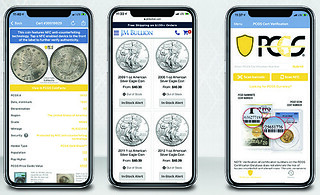 The rise of the home computer industry in the late 1970s and early ‘80s helped lower the cost of owning personal computers, ensuring that tens of millions of Americans had digital portals in their homes by the end of the 20th century.
The rise of the home computer industry in the late 1970s and early ‘80s helped lower the cost of owning personal computers, ensuring that tens of millions of Americans had digital portals in their homes by the end of the 20th century.
Yet by the turn of the 21st century, people were no longer tied to their in-home computers. Advances in microtechnology made owning portable laptops cheaper in the 1990s. And this led to the creation of even smaller tablets and increasingly powerful cellular phones, the latter able to do so much more than simply place and receive calls, by the 2000s.
Even while many in the coin hobby largely remained absent from the digital scene during the 1990s and early 2000s, it was becoming increasingly difficult to avoid the new technology. Coin dealers realized the benefit of online technology and were creating interactive ecommerce portals to buy and sell coins over the internet. Third-party coin grading services also built online presences to make the submission of coins for authentication and grading easier, as well as to offer a host of other educational resources.
To read the complete article, see:
Coin Collecting and Investing In the New Digital Age
(https://www.coinagemag.com/coin-collecting-and-investing-in-the-new-digital-age/)
Kavan Ratnatunga passed along this Reuters article about a potential Bank of England cryptocurrency. Thanks. -Editor
British finance minister Rishi Sunak told the Bank of England on Monday to look at the case for a new "Britcoin", or central bank-backed digital currency, aimed at tackling some of the challenges posed by cryptocurrencies such as bitcoin.
A BoE-backed digital version of sterling would potentially allow businesses and consumers to hold accounts directly with the bank and to sidestep others when making payments, upending the lenders' role in the financial system.
"We're launching a new taskforce between the Treasury and the Bank of England to coordinate exploratory work on a potential central bank digital currency (CBDC)," Sunak told a financial industry conference.
Soon after, Sunak tweeted the single word "Britcoin" in reply to the finance ministry's announcement of the taskforce.
To read the complete article, see:
‘Britcoin' not bitcoin? UK considers new digital currency
(https://www.reuters.com/business/finance/uk-launches-taskforce-potential-bank-england-digital-currency-sunak-2021-04-19/)
THE COIN AND CURRENCY CLUB
Joe Esposito passed along this website for a new company offering monthly deliveries of coins and currency from different countries around the world. Thanks. -Editor
 A New Country Every Month!
A New Country Every Month!
The money we use does more than just provide a means of trade: it tells a story of who we are. Whether it is of kings of a bygone era, wartime heroes, or feats of art and science, every coin and banknote has a story to tell. Coin and Currency Club brings these stories to you. Every month we deliver a coin and banknote from a different country along with informative cards full of photos, graphics, facts, and statistics of the subject nation and figures on the currency. We also include a flag sticker of the nation for you to collect! Whether you are a hobbyist looking for an engaging way to expand your collection, a traveler scoping out new destinations, or a parent looking to show your kid the beauty and vastness of the world and different cultures, Coin and Currency Club will inspire the curiosity of everyone!
About Us
My name is Zachary Lowry. I started collecting currency when I was 10 years old, and it directly led to a lifelong fascination with finance, history, the world, and the interplay between the three. I believe collecting and studying currency is paramount to understanding our complex world, and understanding our world is necessary to building a better future for ourselves. Toward that end, I founded this company and now run it with my wife. I hope our foreign currencies inspire the same fascination in you or your children as they did in me.
To read the complete article, see:
Coin and Currency Club
(https://coinandcurrencyclub.com/)

